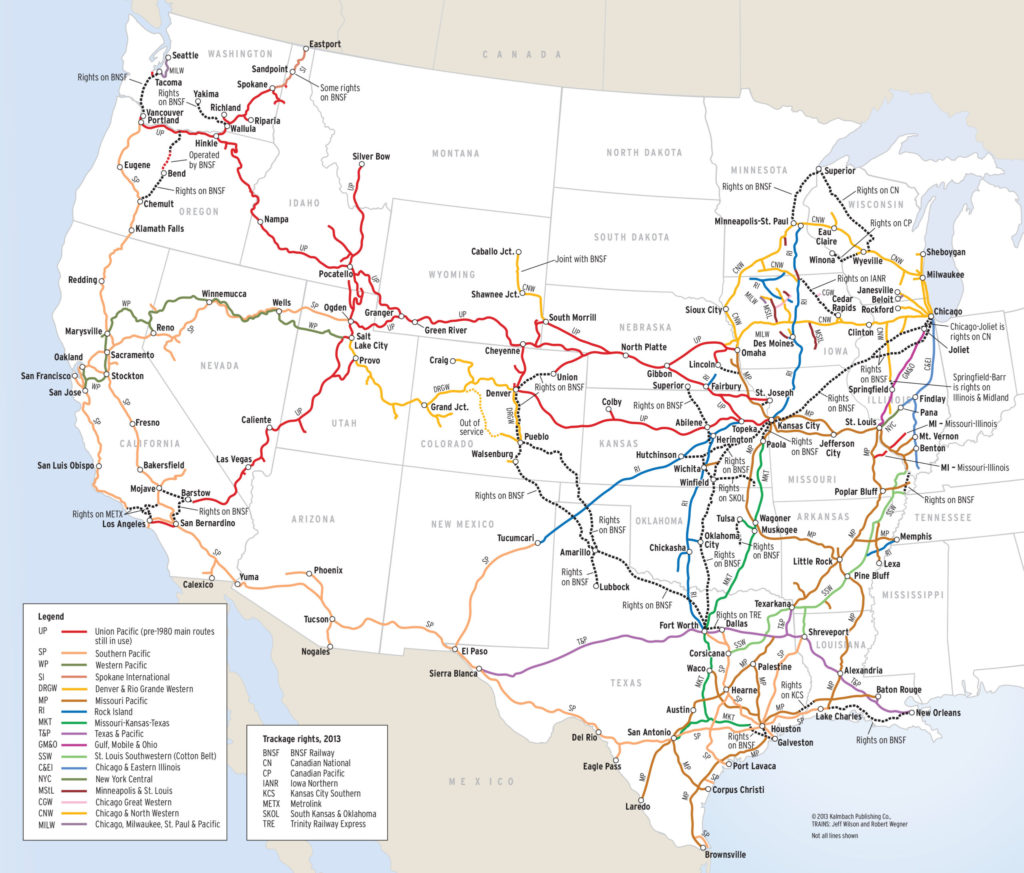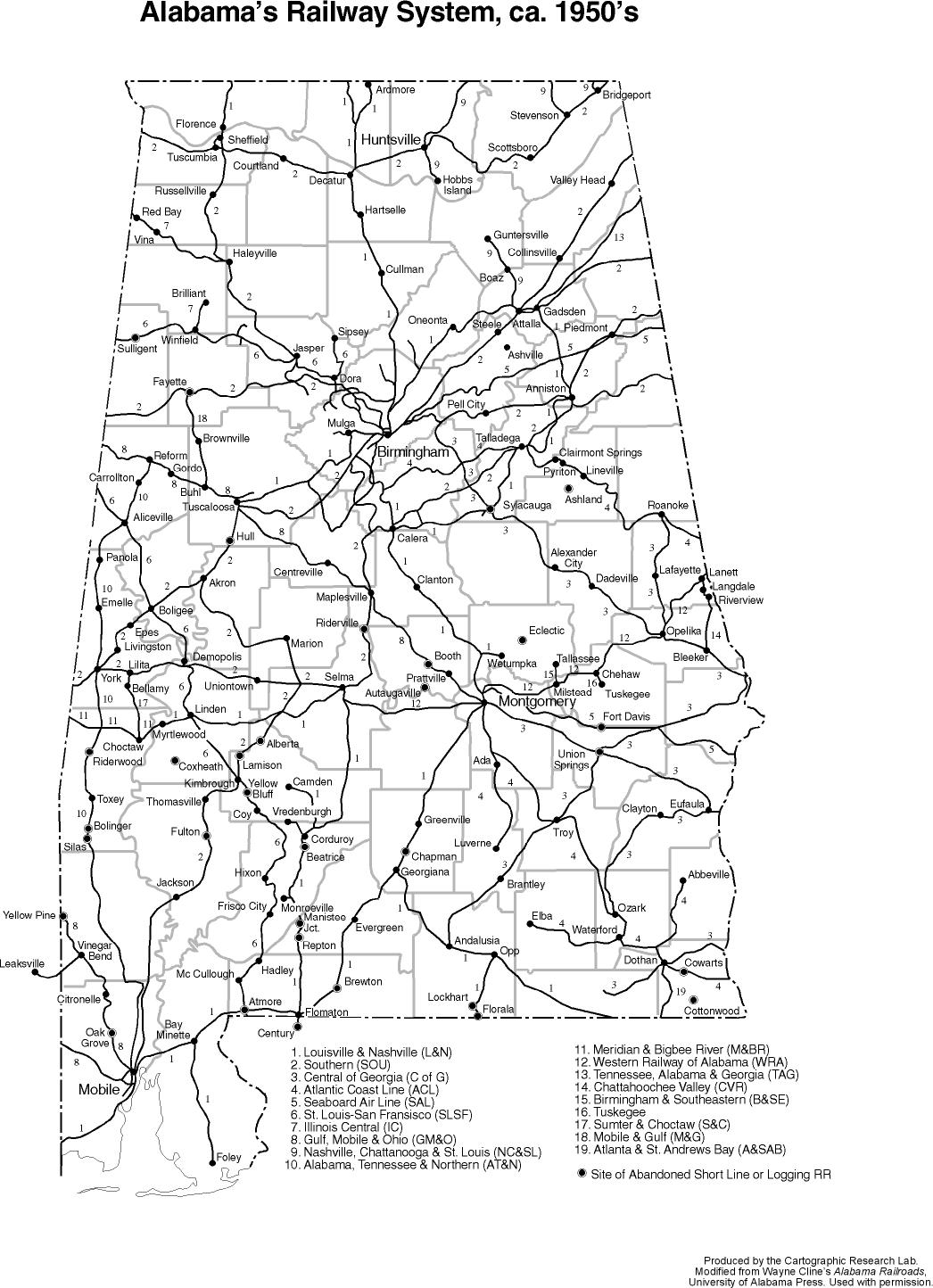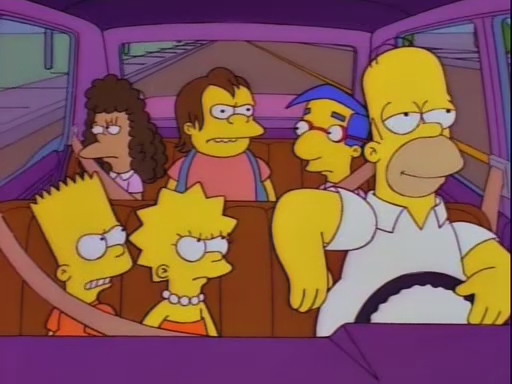Source: https://www.trains.com/trn/railroads/maps/union-pacific-railroad-map-2013-routes-and-major-cities/
Author: jeff_robertson
More links to map resources
Historical and general reference
- USGS TopoView – entry point for all current and historical topographic maps published the US government; can download maps or display them overlayed within the main viewer
Railroads
- Federal Railroad Administration – Safety Map – shows active rail lines, mileposts, grade crossings, etc.
- Georgia Railroad Map (PDF)
Outdoors, off-roading, etc.
- U.S. Forest Service – Interactive Visitor Map – shows national forest locations, forest service roads, trails; indicates if roads are paved, dirt, 4wd-only.
- Forest Service Roads – Chattahoochee-Oconee National Forest – color coded by road status (open, seasonal, temporarily closed, permanently closed)
- Georgia Wildlife Resources Division – Interactive Map – shows state Wildlife Management Area locations, hunting, fishing, camping, shooting ranges, roads. I have learned not to trust these maps to be up to date about road closures!
- Direct links to maps of individual WMA’s:
- MyTopo – Online Maps – these are older USGS topo maps overlayed with some such as forest service road numbers. In spite of some maps being outdated, the simple interface makes for a quick reference.
- Georgia DOT Maps – Index to county road maps, which are basically the only maps online that actually show the paved or dirt status of all roads outside of national/state forests! Reasonably up to date. Unfortunate interface requires downloading individual county maps one by one.
- Trails Off-Road Map – detailed trail guides for individual roads, including photos, videos, reviews. Requires sign-up with email address, facebook, etc. Some features (including to view all trails on the map at the same time) require paid membership.
- Georgia Trails/Offroad Registry – user contributed map, publicly editable; not sure how up to date
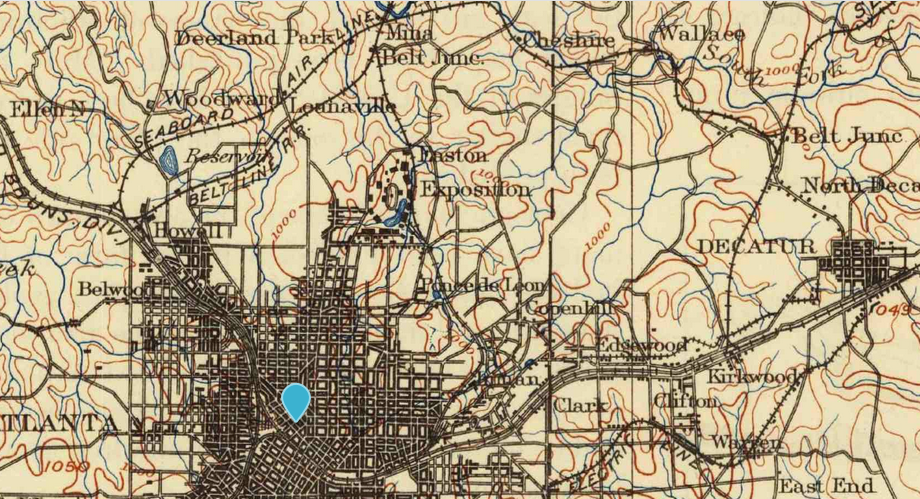
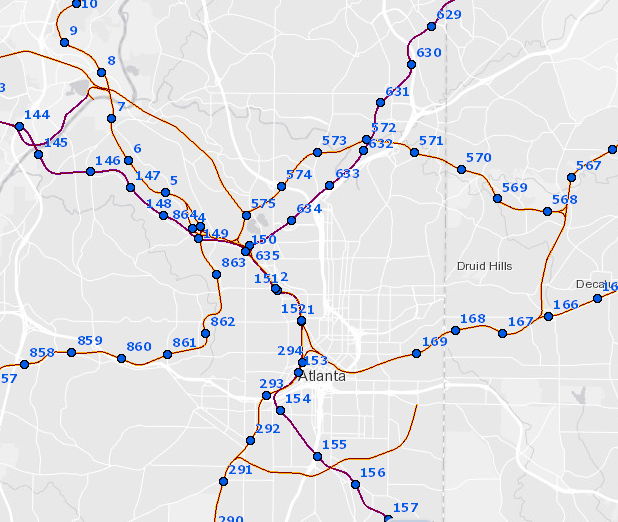
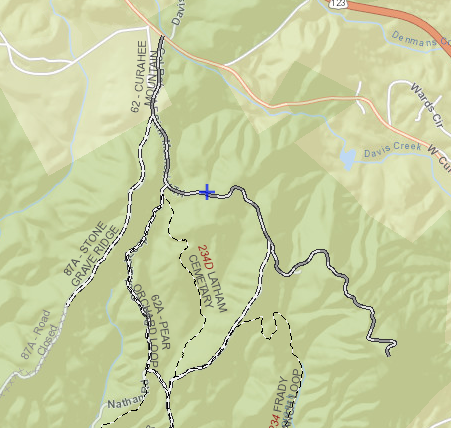
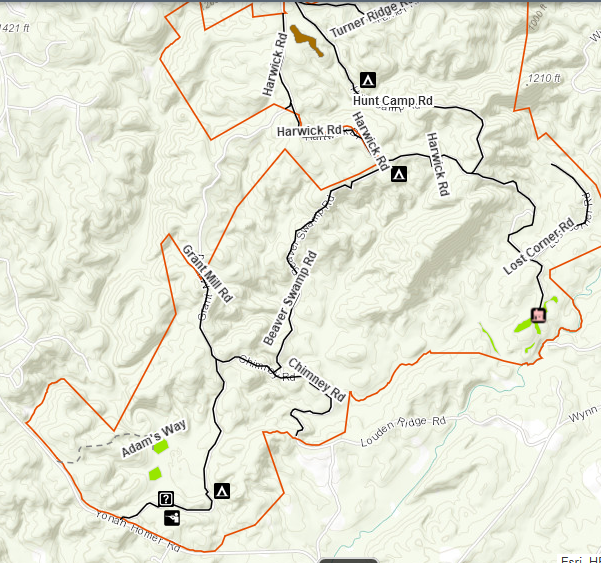
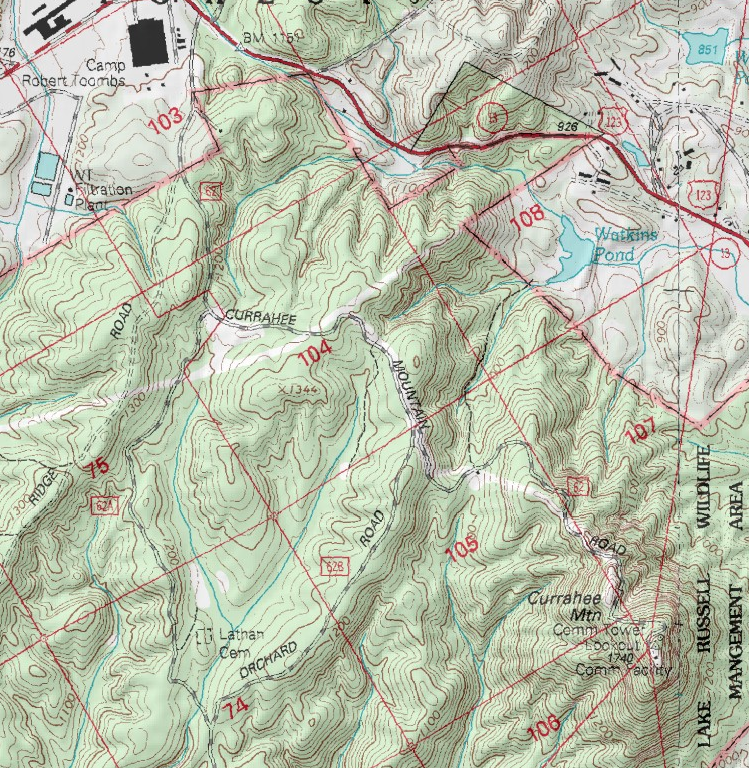

Direct links to archived railga.com pages
RailGA.com was the most comprehensive site on the net for information about railroads in Georgia, until a couple of months ago when it just mysteriously went down.
Fortunately most of the pages were archived by the Wayback Machine.
Alabama Railroad System, 1950s
Dadsplaining Dad-Rock, Part II – The Metal Years
Part of “an incomplete history of hard rock, heavy metal, and punk rock music”, continued from here.
I am going to dispense with most of the commentary and concentrate on simply listing things. Otherwise I will never actually finish any of these posts. As with part 1, videos disappearing off of youtube is a constant threat to the usefulness of these links. Ye have been warned.
Heavy Metal – the NWOBHM and its fellow travelers
Many of the bands here were part of the “New Wave of British Heavy Metal” (NWOBHM) circa 1979-1982. Confusingly but predictably, this music is now referred to as Traditional Heavy Metal.
NHOBHM wasn’t so much a single musical style as a cultural movement, and elements of later genres can already be heard.
- Judas Priest
- Victim of Changes (1976)
- Dreamer Deceiver / Deceiver (1976) – this is actually two songs, the transition is around 6:00
- Sinner (1977)
- Dissident Aggressor (1977)
- Exciter (1978)
- Beyond the Realms of Death (1978)
- Stained Class (1978)
- Hell Bent for Leather (1978)
- Rapid Fire (1980)
- Metal Gods (1980)
- Breaking the Law (1980)
- Living After Midnight (1980)
- Heading Out to the Highway (1981)
- The Hellion / Electric Eye (1982)
- You’ve Got Another Thing Coming (1982)
- Screaming for Vengeance (1982)
- Riding on the Wind (1982)
- Jawbreaker (1984)
- Ram it Down (1988)
- Painkiller (1990)
- Bands with Ronnie James Dio on vocals
- Rainbow – Man on the Silver Mountain (1975)
- Rainbow – A Light in the Black (1976)
- Rainbow – Kill the King (1978)
- Black Sabbath – Neon Knights (1980)
- Black Sabbath – Heaven and Hell (1980)
- Black Sabbath – The Mob Rules (1981)
- DIO – Holy Diver (1983)
- DIO – Rainbow in the Dark (1983)
- DIO – The Last in Line (1984)
- Motörhead
- Sledgehammer
- Trust
- Saxon
- Diamond Head
- Ozzy Osbourne
- Iron Maiden
- Sanctuary (1980)
- Running Free (1980)
- Murders in the Rue Morgue (1981)
- Twilight Zone (1981)
- Invaders (1982)
- The Number of the Beast (1982)
- Run To The Hills (1982)
- Hallowed Be Thy Name (1982)
- Where Eagles Dare (1983)
- Flight of Icarus (1983)
- The Trooper (1983)
- Aces High (1984)
- Two Minutes to Midnight (1984)
- Flash of the Blade (1984)
- Powerslave (1984)
- The Rime of the Ancient Mariner (1984)
- Alexander the Great (1986)
- Seventh Son of a Seventh Son (1988)
- Samson
- Cirith Ungol
- Tygers of Pan Tang
- Hollow Ground
- Witchfynde
- Holocaust
- Blitzkrieg
- Venom
- Welcome to Hell (1981)
- Angel Dust (1981)
- Black Metal (1982) – Black Metal the genre is named after this song
- Countess Bathory (1982)
- Witchfinder General
- Mercyful Fate
- Grim Reaper
- Stormwitch
Glam Metal and its strange bedfellows
Glam Metal (also known as “Hair Metal”) was not so much a musical fusion of Heavy Metal with Glam Rock, as the adoption of Glam Rock hair and clothing by hard rock and metal bands. The earliest Glam Metal was, musically speaking, almost indistinguishable from the Heavy Metal listed above. But these similarities faded fast.
By the late 80s, Glam Metal was so popular that it was the “default” style of hard rock in the popular mind. The genre nearly vanished from public view during the 90s.
- Def Leppard
- Mötley Crüe
- Live Wire (1981)
- Too Fast For Love (1981)
- Shout At the Devil (1983) – unavailable due to copyright enforcement
- Looks that Kill (1983)
- Too Young to Fall in Love (1983)
- Home Sweet Home (1985)
- Wild Side (1987)
- Girls, Girls, Girls (1987)
- Kickstart My Heart (1989)
- Don’t Go Away Mad (Just Go Away) (1989)
- Hanoi Rocks
- Steeler
- Quiet Riot
- Dokken
- Whitesnake
- Twisted Sister
- Ratt
- W.A.S.P.
- Bon Jovi
- Poison
- Cinderella
- Guns N’ Roses
- Faster Pussycat
- Great White
- Rock Me (1987)
- Once Bitten, Twice Shy (1989) – surprisingly few people know this was a cover
- White Lion
- Circus of Power
- Britny Fox
- Winger
- L.A. Guns
- Skid Row
- Slaughter
- Warrant
- Extreme
- Ugly Kid Joe
Speed Metal
- Accept
- Exciter
- Helloween
Neoclassical Metal and other “shred” artists
- Yngwie Malmsteen
- Steve Vai
- Flex-Able (1984)
- The Audience Is Listening (1990) – music starts around 1:08 if you want to skip the spoken intro
- Racer X
- Joe Satrianni
- Tony McAlpine
- Vinnie Moore
- Cacophony
- Jason Becker
Thrash Metal
The darker, edgier, heavier Metal of the mid to late 80s. The sonic characteristics that defined Thrash have become so widely diffused, in the 21st century to say that a band or genre is influenced by “metal” is mostly synonymous with saying they have a Thrash influence.
- Metallica
- The Four Horsemen (1983)
- No Remorse (1983)
- Seek and Destroy (1983)
- Fight Fire With Fire (1984)
- For Whom the Bell Tolls (1984)
- Fade to Black (1984)
- Master of Puppets (1986)
- Disposable Heroes (1986)
- Leper Messiah (1986)
- Orion (1986)
- ..And Justice For All (1988)
- One (1988)
- Harvester Of Sorrow (1988)
- Enter Sandman (1991)
- Slayer
- Anthrax
- Megadeth
- Mechanix (1985) – evolved from the same song as Metallica’s “The Four Horsemen”
- Peace Sells (1986)
- The Conjuring (1986)
- Set the World Afire (1988)
- In My Darkest Hour (1988)
- Holy Wars.. the Punishment Due (1990)
- Hangar 18 (1990)
- Exodus
- Nuclear Assault
- Overkill
- Death Angel
- Testament
Etc.
Stuff that simply has to be listed but doesn’t fit elsewhere on the page.
- The Cult
- Samhain – since both the Misfits and Danzig are on these lists, kind of have to include Samhain somewhere
- Danzig
- Drivin N Cryin
- The Black Crowes
Coming in part 3: 80s hardcore, crossover thrash, alternative metal, etc etc
Junker’s Rebellion
A comic that I drew during the 1992-1993 academic year, mostly during first period A.P. Spanish II, taught by “Señor Bryant”.
These strips were the first mention of “Fluxum Florum” (later spelled FLVXXVM FLORVM), some time before I thought to start using it as a musical alias.
This strip is probably a redrawn version of a lost original. You can tell by the late date (too late for that school year), the fact that it is inked, and the fact that it is not on 3-hole notebook paper. These very-evenly-sized panels were created on a computer, printed out, and inked-over so they looked drawn.

This is a genuine drawn-in-class one. It was the introduction of Junker’s nemesis, “Spearmint Sherry”. The “Franco-Prussian War Flying Ace” was a running gag, of which this was the first instance.
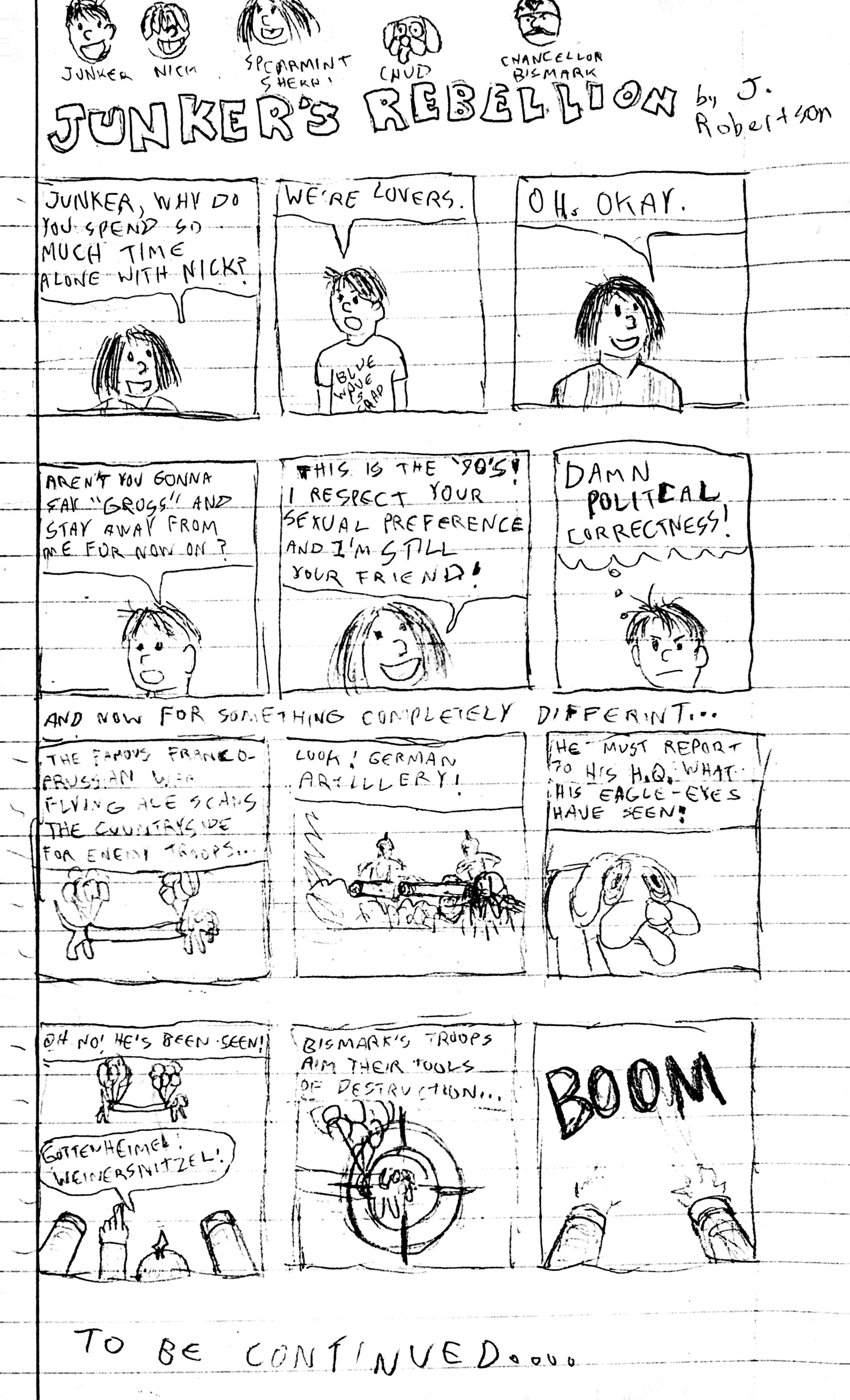
Another re-drawn one on printer paper, a tribute to Dr. Demento:
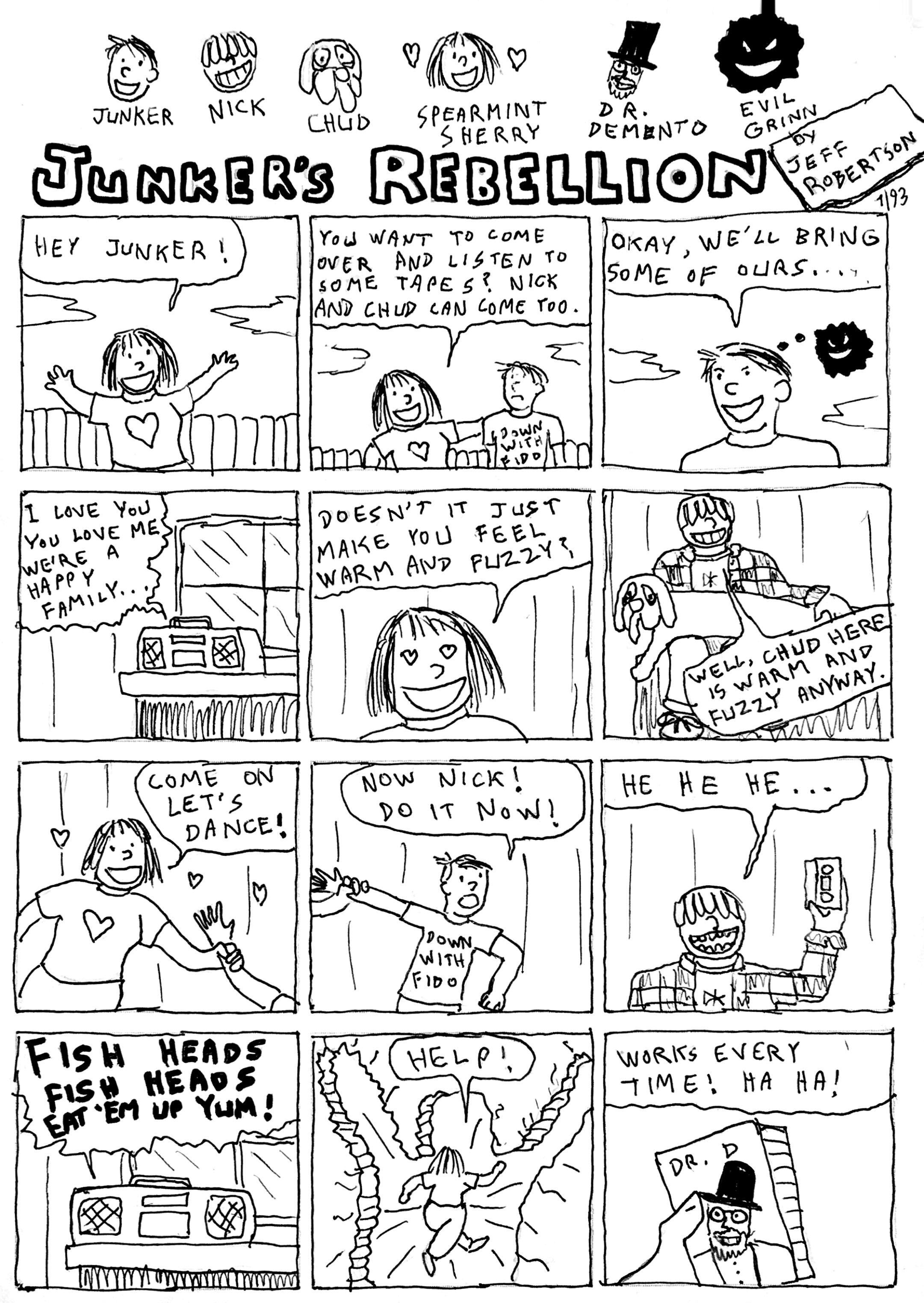
A roughly drawn two-parter that mentions Fluxum Florum and sees the introduction of “Kermit Grande”.

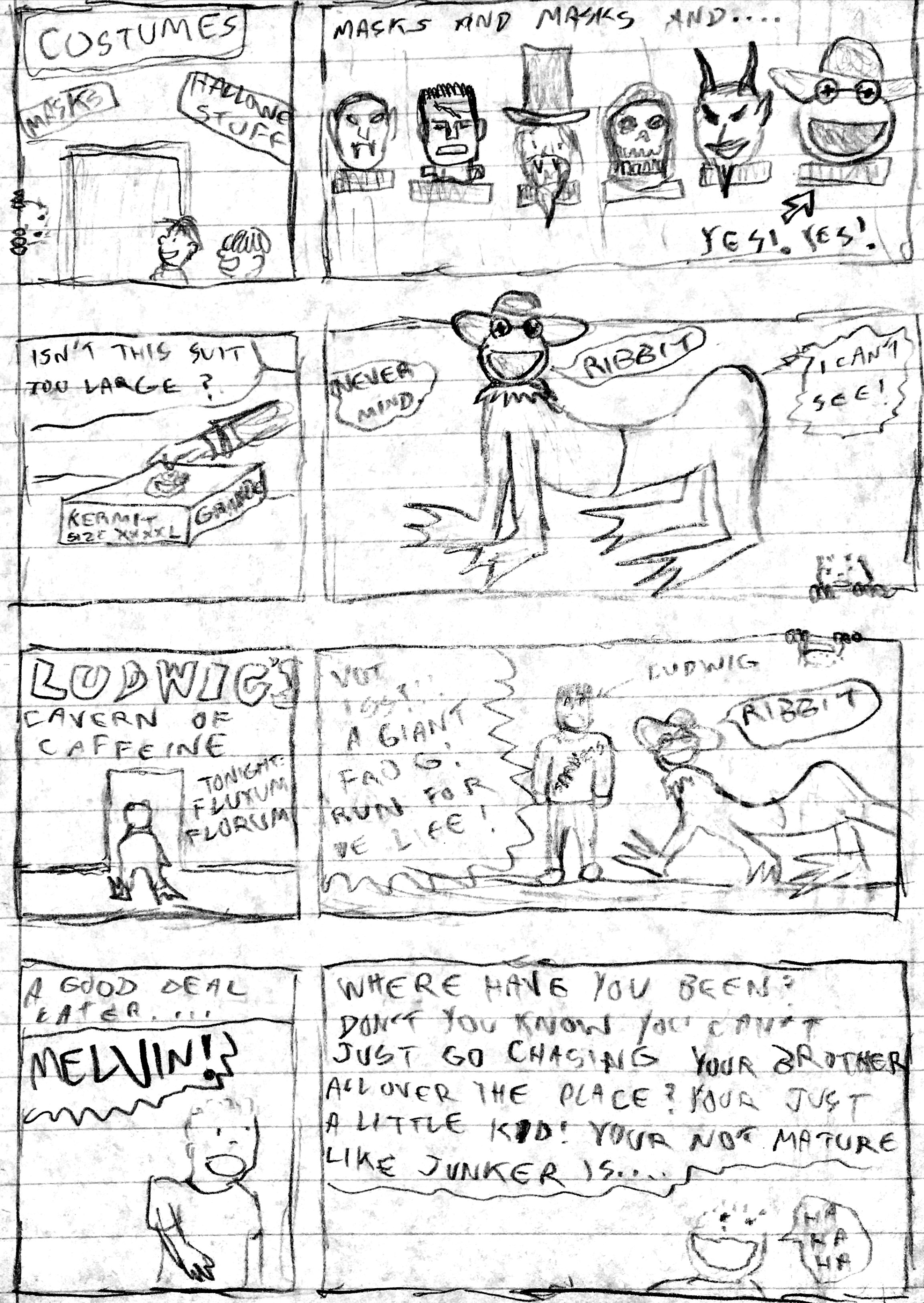
I’m pretty sure this Holodeck was not the only Trekkie reference in the strip. I distinctly recall one where Kermit Grande was a Ferengi.

A stand-alone drawing of “Kermit Grande”:

Three more genuine classroom productions. This one, the version I chose to scan was a photocopy made soon after drawing it. It is better preserved than the pencil version.
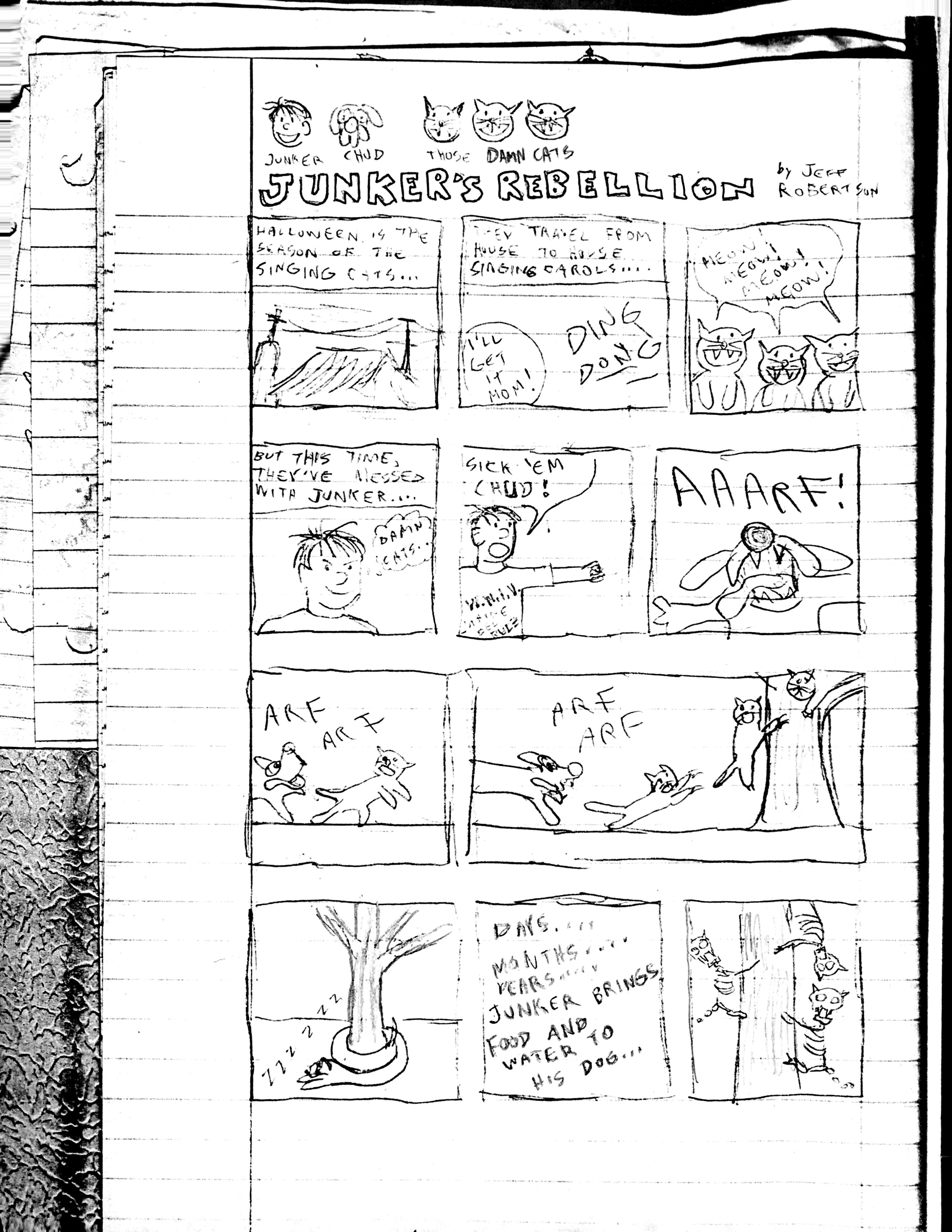
A really rough one. The “small people” here refers to, if I recall correctly, an internal parody of “Mr. Men and Little Miss” that may or may not have appeared in other strips.
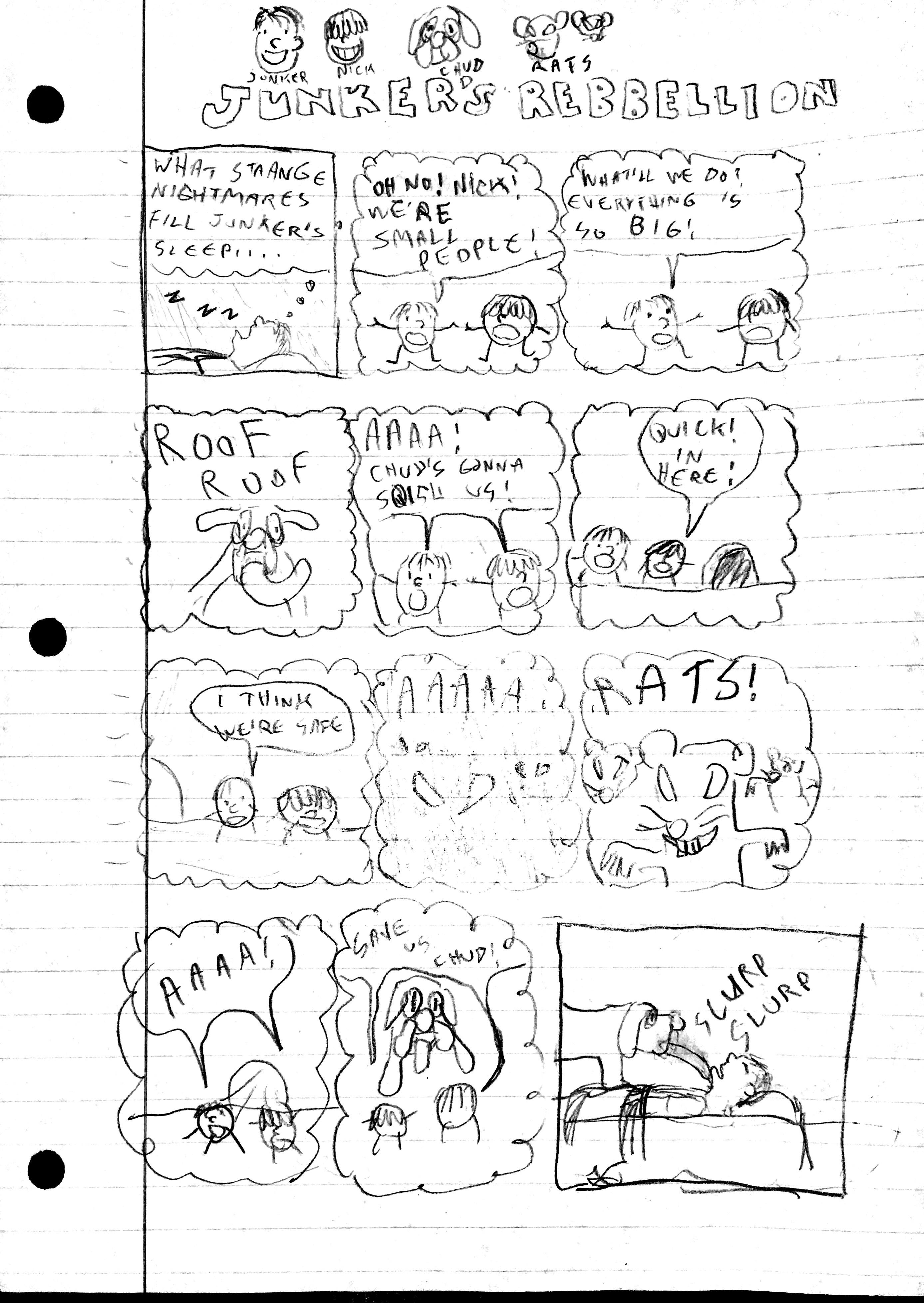
The “Ben Gray” in this strip is not, as some have assumed, a parody of Ben “The Thing” Grimm. (He doesn’t even look like The Thing, ffs) He is rather a fairly accurate depiction of a classmate. “Junior” is an accurate rendering of the sign from a convenience store of that name close to the school.
Note the backstory of Junker’s parents was changed from that depicted in the first strip shown above. At some point I decided that they were not just generic “square middle aged people”, but very specifically they were “square middle aged people who used to listen to punk rock back in like 1977 or something”.
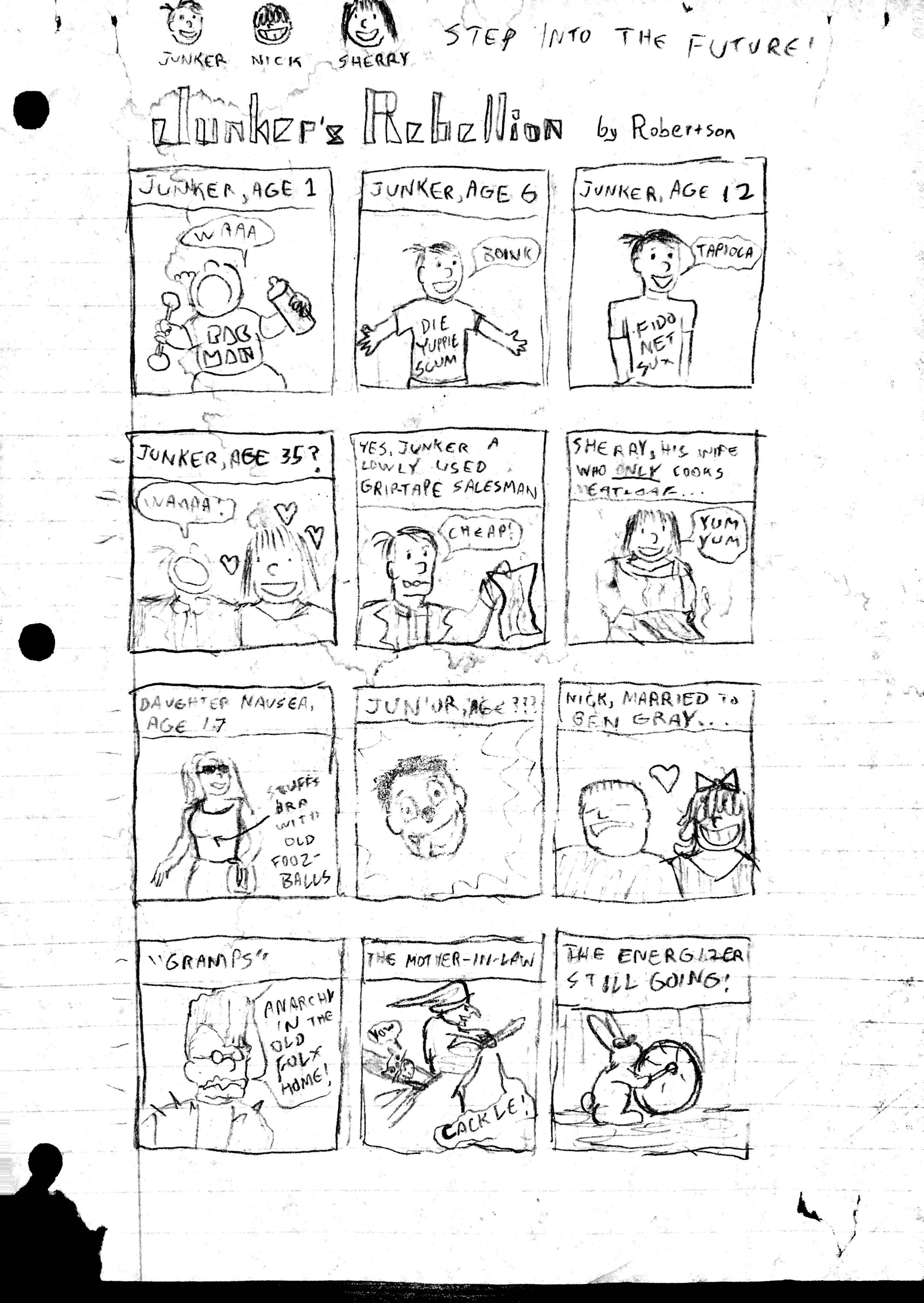
Here’s two more strips involving the “Franco Prussian War Flying Ace”. I did these in pencil with the intention of tracing in ink later, but never did. The fact that the letterhead and panels appear to be printed on something better than a dot matrix suggests these were much later than all the others here. (I have no memory of having any access to inkjet or laser printers at any time while in high school)


Shit My Kids Said – compilation #1
In no particular order. Culled from various posts and emails where I quoted them.
4/7/12, kid #2:
“I wish *I* was a nerd”
5/5/12, kid #2:
“no matter where you go, you’re on top of the world”
7/29/12, kid #1, on Martin Prince from the Simpsons:
“I think he _wants_ to get punched. I think he _enjoys_ it.”
7/8/12, kid #1 on college:
“Change my name, get contacts, start a whole new _punk_ style…”
5/5/12:
me: do you like reggae?
kid #2: what?
Me: this kind of music (Bob Marley playing)
kid #2: no. why would you think I would? I’m a little girl.
4/8/12, kid #1:
“I don’t pick up pennies if I drop them.. they will make some little kid happy, because it might be their lucky penny”
8/17/12, kid #1:
“Dogs are like friends. Sort of. You don’t walk your friends. And don’t talk to your dogs in front of people, only in private”
10/16/11, kid #1:
“Shel Silverstein wrote some _weird_ poems!”
2/13/15, kid #1, context lost in the mists of time:
“Oh no no no, I forgot my eyes! I forgot my eyes!”
3/2/12, kid #2, watching “Bizarre Foods with Andrew Zimmern”:
“I want it, I want it, I want it!”
7/1/12, kid #2:
“Almost nothing _men_ wear is fashionable.”
2/3/12, kid #1, on some “ninja warrior” type show:
“they don’t show the episodes where people die”
2/12/12, kid #1, on bluegrass:
“This music makes me want barbeque”
12/17/11, kid #1, on Reader’s Digest:
“Don’t tell anybody I was reading that. It’s a magazine that old people read to help them poop”
3/26/12, kid #2:
“The two words I hate most in the world? Funky and groovy”
4/27/12, kid #1:
“anything cute renders us helpless”
12/3/11:
“I’m crying because I know someday I’ll have to be a crazy old lady”
5/5/12, kid #2:
“we’re never going to be in the eighties, Dad, so why are you telling us about them?”
8/17/13, kid #1:
“We are living through one of those times that people are going to look back on and say we had good cartoons”
8/2/13, kid #2:
“Maybe old people like margarine because it sounds like an old person’s name.”
8/17/12:
kid #2: oh no.. it’s [boys’ name]. Do I have anything on my face?
Me: yes
kid #2: (wiping face) I’m gonna go annoy him, cuz I hate him.
9/22/13, kid #1:
“I don’t drink ‘normal’ coffee. I drink the expensive kind.”
1/31/15, kid #2:
“There’s a seed in this orange. I’m suing the company”
7/15/12, kid #1 to #2:
“That’s _not_ a vampire haircut”
1/9/12, kid #1:
“You can’t just say ‘I wish to be healthy’ when you make a wish, say something like ‘ward off illness’ or ‘summon great health'”
7/22/13, at the swimming pool:
kid #2: my arch enemy is in the shallow end.
Me: who?
kid #2: we do not speak of him. (quietly) lets get in the pool and ignore him.
9/2/12, kid #2:
“I don’t trust candy from little boys. I don’t trust little boys.”
12/23/11, kid #2:
“My life is awesome. Everybody thinks I’m so adorable that I get away with everything”
7/15/12:
kid #2: “I want to be a vampire”.
kid #1: “you’ll be seven years old forever”.
kid #2: “I meant when I’m sixteen”.
7/27/11, kid #1, on a Pac-Man wedding cake:
“I just love that. I want that for my wedding. If he doesn’t agree to it, I’ll dump him”
9/2/13, kid #2:
“Being so awesome is tiring”
5/22/11, kid #2, a positive review of restaurant ramen:
“I couldn’t have cooked these noodles any better myself!”
7/19/11, kid #2, on “orange” cough syrup:
“It doesn’t taste like the fruit, it tastes like the color.”
6/24/11, kid #1 watching the “Man vs Food” guy cry in pain from spicy bbq:
“I wish I could have some of that”
6/19/11, kid #1:
“So few people know that ‘thrice’ is a word”
6/19/11, kid #1:
“The closest thing to winning is losing”
7/24/11, kid #1, when learning the US was founded by slave-owners:
“Oh God that’s ironic!”
“But I thought they were the Good Guys!”
“Ooh I hate the government”
4/28/12, kid #1, on reading history:
“The underdogs you root for always turn into bullies in the next chapter”
10/12/13, kid #1:
“You said you were going to drop the bass, you just sat it down carefully. You need to throw the bass down like you hate it, break it into a lot of little pieces..”
6/15/15, kid #1 watching “Golden Girls”:
“I hope I find friends like that. Otherwise I’ll have to live in a one room apartment with just a cat to keep me company. I don’t want to wait until I’m *old* to live in a big house with all my friends. I want to do that in my 20s!”
3/26/15, kid #1 after learning about household budgets at school:
“I plan to be single and childless and live in a tiny apartment and eat ramen, so even if I don’t make much money I’ll be able to spend it on whatever the fuck I want”
10/18/13, kid #1:
“I found another idiot on the Internet!”
11/29/14, kid #1, on Ugg boots:
“these will go with my intense craving for Starbucks”
10/8/15 conversation after we saw a train carrying what look like giant pipes:
Me: “I bet those are sewer pipes. Someday they’ll be full of poop.”
Kid #1: (groans) “dad..”
Me: “Who knows, some of those pipes could end up carrying *our* poop.”
Kid #1: “dad, what the actual fuck?”
5/11/16: kid #1 got 2-weeks banned from miiverse for posting “you don’t have to be lonely at farmers only dot com” as a joke.
2/28/15:
kid #1: what kind of person puts cream cheese on a croissant?
kid #2: you’re just jealous you don’t have a croissant.
#1: I don’t want a croissant!
#2: you’re just jealous you don’t have cream cheese.
#1: no, I hate cream cheese!
#2: you’re just jealous you don’t have a cream cheese croissant!
#1: just eat it, you freak of nature.
#2: here. You must try the cream cheese croissant
#1: [takes a bite] that’s quality!
#2: who’s the freak of nature now?!
1/30/14: kid #1 has read all about “bigots” and “allies” from tumblr or somewhere, pronounces these words as “bye-gots” and “alleys”.
5/9/14, kid #1 assorted quotes:
“If you take yourself seriously as a shipper, you better get over homophobia, because everybody knows the most kawaii pairings are not straight”
“The boys that like me are the socially awkward ones that you feel sorry for. Don’t get me wrong, it’s great having guys that will do whatever I say..”
(Looking at drawings of women dressed like the anthropomorphic representations of foods) “this is what I’m gonna wear to the prom!”
5/12/18, kid #1 (be note this was said while my wife was in labor with kid #3):
“I’m legally changing my name to Mother Shabubu”
6/6/14, kid #1:
“When I go to college I’m gonna be that roommate everyone wants, because I’ll already know how to make ramen”
1/1/15, kid #1:
“The only reason anyone drinks Faygo anymore is because of Homestuck”
1/28/14, #1 on the state of “Invader Zim” fan fiction:
“Oh my god the Mary Sue’s have taken over”
5/2/14, kid #1:
“When I get in high school I’m gonna dye my hair teal, and people are gonna call me ‘that weirdo with the blue hair’, and I’m gonna be like, ‘it’s not blue, it’s teal!!'”
4/13/14, kid #1:
“let’s go out in ironically bad homestuck cosplay!”
3/11/15, kid #1:
“What if the characters on Regular Show aren’t actually anthropomorphic animals, what if they are just people in suits, and no one questions it?”
3/29/16, kid #1:
“When you’re a little girl everybody thinks you should love horses, but they’re terrible. They’re ugly and they smell and they are not anywhere as majestic as you see in the movies. I don’t mind My Little Pony, but that is the only exception”
12/15/15, kid #1:
“The internet was a mistake”
11/15/14:
(TV ad about how if you buy some thing you won’t have to pay until 2020)
Me: that’s when you graduate high school
kid #1: it’s like there’s a giant number “2020” gently tapdancing towards me.
#2: breakdancing towards you
#1: yes, gently breakdancing towards me
#2: you can’t break dance gently. You have to go all the way.
1/27/16, kid #1:
“I hate this new trend of getting girls with soft, smooth, clear voices to do voiceovers for commercials. Her voice makes me want to punch somebody”
5/20/11, watching some movie where a child cusses in one scene:
kid #1: “how’s a kid know those words?!”
me: “from movies like this”
kid #1: “oh, yeah..”
7/7/17, kid #1:
“Taco Bell, Pizza Hut, and KFC – the Triple Entente”
10/5/14:
kid #2: I’m gonna work at Hot Topic.
kid #1: hopefully by the time you’re old enough to get a job, Hot Topic will be outlawed.
11/21/13, kid #1 watching fractal zoom videos:
“It’s like I’m a drugged-out hippie!”
5/23/17, kid #1, working on a big project the night before it was due:
“You know Mozart finished one of his symphonies just minutes before they played it live!”
12/23/14, kid #1, while at Whole Foods:
“Every class always has that one kid who smells weird because their mom is a hippie that only shops at Whole Foods”
7/29/14, kid #1:
“Animal Crossing is my anti-drug”
7/3/15, kid #1, on “Cats”:
“When I see the poster for it I don’t think ‘that looks like a respectable Broadway musical’, I think ‘that’s just a bunch of furries'”
7/19/15:
Me: why are you dressed up? We’re just going to the drive through, you’re not even going to get out of the car.. are you cosplaying!?
kid 2: no
kid #1: but you do kind of look like you could be a character from something
kid #2: then other people can cosplay as ME
2/6/14, kid #1:
“We can listen to some of your music as long as there’s no flutes involved”
(You make the kids listen to “Thick as a Brick” just once, and you never live it down)
1/7/16, kid #1:
“I have connections on the the Dark Web”
12/19/14, kid #1:
“Kids are terrible”
5/3/15, kid #1 on internet trolls, or something:
“Internet people are real live people. They’re out there somewhere. Just because they don’t live near you, doesn’t mean they don’t live near someone..”
4/24/14:
Me: do you have homework?
kid #2: no
Me: then what are you working on ?
kid #2: I have a list of kids who are paying me to draw ponies for them.
3/30/11, kid #2 on those touch-screen soda fountains:
“It’s like an iPhone that gives you drinks”
11/2/14:
Kid #2: “Can we go to one of those hipster areas?”
Kid #1: “They don’t have grumpy old people telling you to get off their lawn, they just have grumpy old goth chicks giving you disapproving side-eye looks”
7/22/17:
Kid #2: …something something something… had to shut their twitter account down.
Kid #1: glad to hear Furry Twitter is still woke.
Kid #2: yeah furries are accepting of everybody, unless you’re a fuckboy.
Me: what?
Both: nothing!
7/22/17:
(Listening to “don’t trust me” by 3OH!3, and the line “do the Helen Keller”)
#1: that’s so wrong, but it’s Helen Keller so I don’t care
#2: what did Helen Keller ever do to you?
#1: uh, I think she was racist or something… maybe she was one of those people that says they “don’t see color”…
7/18/15, kid #2:
“I don’t want to eat somewhere called ‘Pizza Den’. It sounds like eating pizza in some guy’s basement that he calls his ‘man cave’ but it’s really just where he keeps his figurines and watches anime all day”
6/12/14, kid #2:
“When I get a Homestuck shirt I’m gonna wear it to school and people will be like, ‘what is that shirt from?’, and I’ll be like, ‘oh it’s just a thing I like. You wouldn’t know about it'”
6/29/13, kid #2:
“I wish I had the power to snap my fingers and instantly make a baby stop crying”
7/16/15, kid #2:
“I would buy that place and open up a House of Witchcraft”
1/9/15, kid #2:
“Doraville: there’s more swiping here than we’d like”
1/7/14, kid #2:
“I wish it was like the 80s when there were arcades everywhere and you could just go to them anytime you wanted”
5/18/13, kid #2:
“The Harlem Shake is over three hundred years old”
10/5/14, kid #2, on Virginia Highland:
“Seems like the kind of neighborhood where everybody has a child named Caden who isn’t allowed to watch more than one hour of TV a day”
“This seems like the kind of neighborhood where the people all have stick figure families on their cars”
“..where the moms have all read ‘Eat, Pray, Love'”
11/17/15, kid #2:
“Remember when we thought the guy from AWOLNATION was Mr. Rogers?”
12/13/14, kid #2, mocking stereotypical geek fandom members:
“I’m not like other girls, I can read!!”
7/16/14, kid #2, wanting to be allowed to play “Cards Against Humanity”:
“I don’t have the mind of a natural nine year old, so I think I’m good”
10/10/13, kid #2:
“There’s a robot that can solve Rubik’s cube in 5.35 seconds and I want to watch it. Don’t crush my dreams.”
7/25/14, kid #2, unimpressed with “Sky Mall”:
“They expect you to put these in your home?!”
1/16/15, kid #2:
“Blame it on the fructose”
4/5/15, in Waycross, GA:
Kid #2: “What is that thing on the water tower?”
Me: “Looks like Pogo Possum”
Kid #2: “He doesn’t look like a possum he looks like a furry version of Squidward”
5/7/16, kid #2, watching an ad for goldfish crackers:
“This is just like Ouran High School Host Club..”
7/23/17, kid #1 seeing one of our dogs with a rawhide bone:
“She looks like she’s smoking a blunt!”
8/19/17, kid #1:
“the only way I’d be a cheerleader is if someone murdered me and turned my body into a marionette”
7/26/15:
kid #1: “me and some of the other girls had fake gay weddings on the last day of school. I married <rattles of two or three names>”
Me: “that’s polygamy. Do you know what that means?”
kid #1: “It means I get all the bitches”.
12/27/14:
9/2/17, kid #1:
“All the kids _like_ Broadway now.”
7/27/17, kid #1 eating some weird blue snack food:
“I feel like for every one of these you eat, that’s another month you have to spend in the underworld with Hades”
7/7/16, kid #1:
“Lisa Frank is true art”
4/21/16, kid #1:
“Why are all these anime set in middle school? *Nothing* happens in middle school!”
10/4/15, kid #1, disapproving of restaurant music:
“It sounds like the default desktop background image of Windows XP is yelling at me”
8/4/15, kid #1:
“I love YouTube channels full of nothing but lyrics videos with small spelling mistakes. You can tell those people haven’t been corrupted by the world yet. They’re just here for the music”
7/2/15, kid #1 (on further questioning she said she meant Ross):
“I can’t really remember what my elementary school science teacher looked like, so I just pretend he looked like the guy from ‘Friends'”
7/1/15, kid #1:
“Who needs to watch sports on TV when you can watch *anime about sports* instead?”
6/24/15, kid #1:
“They should call it *dumb* teens react”
8/5/15, kid #1:
“Isn’t it amazing how I started out as a baby but now I’m basically a fully functional human being who can do things for myself?”
4/23/15, kid #1:
“The only reason I’d want to be a parent is so I can make jokes. If my kid told me, ‘I’m gay’, I’d be like, ‘hi Gay, I’m mom'”
1/18/15, kid #1:
“I know I sound like a hipster, but new SpongeBob is crap”
1/17/15, kid #1:
“The only reason I’d ever sign up for Facebook is if I needed to ‘like’ something to get a discount”
1/16/15, kid #1, on Honey Nut Cheerios:
“I hate him! I hate that bee so much!”
12/24/15, kid #1:
“There’s a reason new stuff is popular: it’s better”
10/23/14:
“We’re pretty sure John Egbert is going to die [soon], so we’re building a shrine”
10/9/14, kid #1:
“It tasted good but I couldn’t stop feeling like we might be eating Menudo the band cooked into a soup”
9/18/14, kid #1:
“So this is why iMovie calls that effect the ‘Ken Burns'”
8/16/14, kid #1:
“You’re literally telling me that every time you see aviators worn with a hoodie, you think of that bomber guy?”
6/28/14, kid #1:
“Memes don’t belong on tv, they don’t belong on tshirts worn by kids too young to know what it is, they don’t belong in pop songs. They belong to the weirdos of the internet!”
6/5/14, kid #1, on “Sylvan Learning” and its ilk:
“Pay money to torture your child all summer”
11/12/15, kid #2:
“Justin Timberlake was in U2”
12/5/14, kid #2:
“Sometimes I think ‘this is a bad dub, I wish I was watching the sub’, and then I remember I’m not watching anime”
12/28/13, kid #2:
“Some people say vinaigrette, some people say vinaiGRAY”
11/13/10:
kid #2: “Too bad I can’t marry this hamburger”
kid #1: “But you’d just end up eating it”
kid #2: “That’s the point!”
2/13/16, kid #2, observing a man change the moveable letters on a tall fast food sign using a telescoping tool to grab them and put them in place:
“I wonder if he enjoys his life. I wonder if he’s satisfied with this occupation”
5/28/15, watching some “true crime” show:
kid #1: that cop looks really gay. Sometimes you can just tell by looking at a guy’s face. It’s in the bone structure.
kid #2: no. he’s married and his wife bosses him around a lot. And he doesn’t understand his kids at all. And he is always barbecuing but he’s terrible at it.
12/29/13, kid #2:
“We are the government, we take your money and kill things..”
3/4/11, kid #1:
“No real boy wears nice clothes”
10/4/13, kid #1, watching “Back to the Future”:
“Who names a kid ‘Biff’? It’s like you _want_ him to punch his way through life.”
“You can tell they’re supposed to be dumb, because they have cows”
“This still doesn’t make her likable, it just makes her a hypocrite!” – on 1955 Lorraine compared to 1985
“No guy who isn’t *looking* to get punched in the face would act like that” – on poor George McFly
4/12/13, kid #1:
“Maybe *I* could be a street performer someday”
4/2/11, kid #1:
“Anime people wear _short_ shorts!”
1/17/11, kid #1:
“Pizza doesn’t laugh. If it could make any noise, it would cry”
1/15/11:
kid #1: “I don’t want to grow up!”
kid #2: “Well you’d have to get bitten by a vampire to stay 9 forever. Apparently vampires aren’t real
12/29/10, kid #1:
“I hate nice things”
12/27/10, kid #1:
“My favorite thing about the holidays is getting a Pez dispenser, filling it up, and eating all the Pez in one day”
12/18/10, kid #1, watching “Hell’s Kitchen”:
“Most of the people that have been on that show committed suicide”
11/15/10, kid #1:
“I love nerdfights”
10/29/10, kid #1, watching “Seinfeld” for the first time:
“This is a horrible, horrible show”
10/15/10, kid #1, on the Iron Giant:
“He’s so cute! I like metal guys.”
9/19/10, kid #1:
“Kids don’t get tired”
8/20/10, kid #1 on computer shopping:
“Get one that has access to Google”
5/30/10, kid #1:
“How many Justin Bieber haircuts do I have to see today? It’s kinda creepy.”
12/12/10, kid #2:
“People are staring at us, wondering ‘why is he letting those little girls drink coffee?'”
7/28/10, kid #2:
“I wonder what Canadian people look like”
10/31/10:
Me: “How’s your steak?”
kid #2: “If I’m gobbling it down in one bite, that means it’s good”.
10/26/10, kid #2:
“There *is* such a thing as an upper-case ‘4’, you know”
10/6/10, kid #2:
“I’ve already told you, you should not mess with me”
11/16/14:
kid #1: here dad put my DS in your pocket and walk around wherever you see a bunch of nerds, so it’ll pick up street passes
Me: I’m not going to creep on a bunch of teenagers for you
kid #1: you don’t have to talk to them, just kinda walk near them
10/19/12, kid #1:
“Don’t be such an eight year old, Dad”
1/28/11:
kid #2: “how do you spell happiness?”
kid #1: “I don’t know, I’ve never experienced it”
9/28/12, adding two new goldfish to the aquarium:
kid #1: I wonder if the new ones have strange accents.
kid #2: Like British accents?
kid #2: They wouldn’t have British accents. All fish fear the British, because of Fish and Chips.
7/6/13, kid #1:
“You mean the government knows what I’ve been texting to my friends?! They know who I have a crush on!”
10/19/12, kid #1:
“I’m so high on pixie sticks I wont be surprised if I wake up on the curb”
11/29/14:
kid #1: The cops in my school only do three things. Enforce dress codes, bust kids for skipping class, and yell at the autistic kids for flapping their arms in the hallway.
kid #2: could you make friends with the cops so they won’t arrest you ?
kid #1: that only works in movies, not in real life.
1/20/12:
kid #1: some guy today gave me his watch and told me to fix it for him and then give it back to him on Monday.
Me: some guy? you mean like a kid your age?
kid #1: yeah, he’s in the same grade (fourth) as me but in a different class.
Me: why does he think you’ll fix his watch?
kid #1: he must have heard about me. I fix lots of stuff.
Me: at school?
kid #1: yes!
Me: like what?
kid #1: There was this really annoying sound in math class that you could only hear when things were quiet, but made it hard to think when you could hear it. It was coming from a little alarm that was connected to some electrical wires, and I saw there was a knob on it that said “turn to silence alarm”, so I started to turn it but you needed a screw driver to turn it with and I didn’t have one, so I started using a paperclip to turn it with. But the principal happened to be walking by and he thought us kids were trying to stick the paperclip in the electrical outlet, so he made a rule that kids were not allowed to touch that thing anymore, and now every day that alarm goes off and there’s nothing we can do about it. The principal didn’t give the teacher the chance to explain what I was doing..
Me: wait, your teacher knew you were messing with the “alarm”? Why did she let you?
kid #1: because I’m the teacher’s pet and she knows I know what I’m doing!
Me: well why didn’t she get you a screwdriver so you wouldn’t have to use a paperclip?
kid #1: for some reason there’s a rule against giving kids construction tools.
Me: I’d like to see this “alarm”. I don’t suppose you could take a picture of it? Do they allow cameras at school?
kid #1: I don’t know, but the other day some guy I didn’t know had his Nintendo DS at school and was taking pictures of me and the other girls with it without asking us.
Me: how old was he?
kid #1: about my age I guess. Why would a boy do that?
Me: I don’t know.. I think I’m going to walk you into your classroom tomorrow so I can see this alarm. I want to get there early so I can see it before anyone else is in the room.
kid #1: ok but don’t mess with it.
10/9/13, kid #1:
“So the New Testament is basically fan fiction.”
11/5/11, kid #1 looks at Hot Topic:
“no thanks, teenagers kind of scare me”
10/19/12, kid #1:
“Disney’s gone steam punk! It’s awesome!”
3/29/13:
Me: So.. you didn’t stay up all night reading fan fiction, you stayed up all night writing it?
kid #1: .. yes
6/29/14, kid #1:
“It’s a good thing you have a beard, Dad. Just having mustache is creepy”
9/26/13, kid #1 watches “Pretty in Pink”:
“I’ve got advice for you Duckie: stop being so creepy.. stop hitting on every girl..”
“I’m not sure what kind of hat that is, but I’m sure it’s not a guy’s hat”
“I would not even be able to talk to a guy who was wearing leopard shorts”
“I don’t care how gay that guy is, dangly earrings are for girls”
“[Andi] is the only girl whose hair doesn’t make me want to punch someone”
“She’s got relatively nice clothes for the time she lives in”
“She’s got stalkers, she can’t be that unpopular”
“I didn’t know hair could have that many spikes! Wow, I’m genuinely impressed!”
“The only thing that guy has going for him is long flowing poofy hair”
“That suit is so floppy! It looks like a suit that a business man would wear but it’s all soft!”
“I wouldn’t let [Duckie] into my home, much less my room”
“This should be a vine!”
“Blane is one of those names like ‘Brad’, and ‘Ryan’, that are always names for popular guys. Girls could be like hey ‘who’s that dork’, but if he says ‘hi I’m Brad’, they’re like ‘oooh, Brad!'”
9/28/12, kid #2:
“Every second gets us closer to when we die”
12/31/13, kid #2, imaging how boys think:
“Oh look a girl! I’ve never seen a real live girl before!”
9/29/12, kid #2, eating devil’s food cake:
“I’m gonna taste some Satan!”
7/31/11, kid #2:
“Someday I’ll get myself a princess job.”
“Standard” Locomotive Cab Variations
Because while writing about wide nose variations I realized there also didn’t really exist such a catalog of non-wide cabs. Conventional road-switchers only!
Except for the railroad custom jobs at the end, standard cabs are not being built new since the 1990s. However, so many were sold over the years that they remain ubiquitous in all situations other than the lead unit on a mainline train: trailing power, locals, switching; not to mention museum-pieces.
EMD
Early high nose
The classic, original EMD look of the 1950s. Used on early road-switchers such as the GP7, GP9, GP18, etc.

Early low nose
Used on a very small number of GP9s, and then on GP18, GP20, etc. The factory low nose sloped downward from back to front. I have seen divided and undivided windshields, not sure if both are original or not.
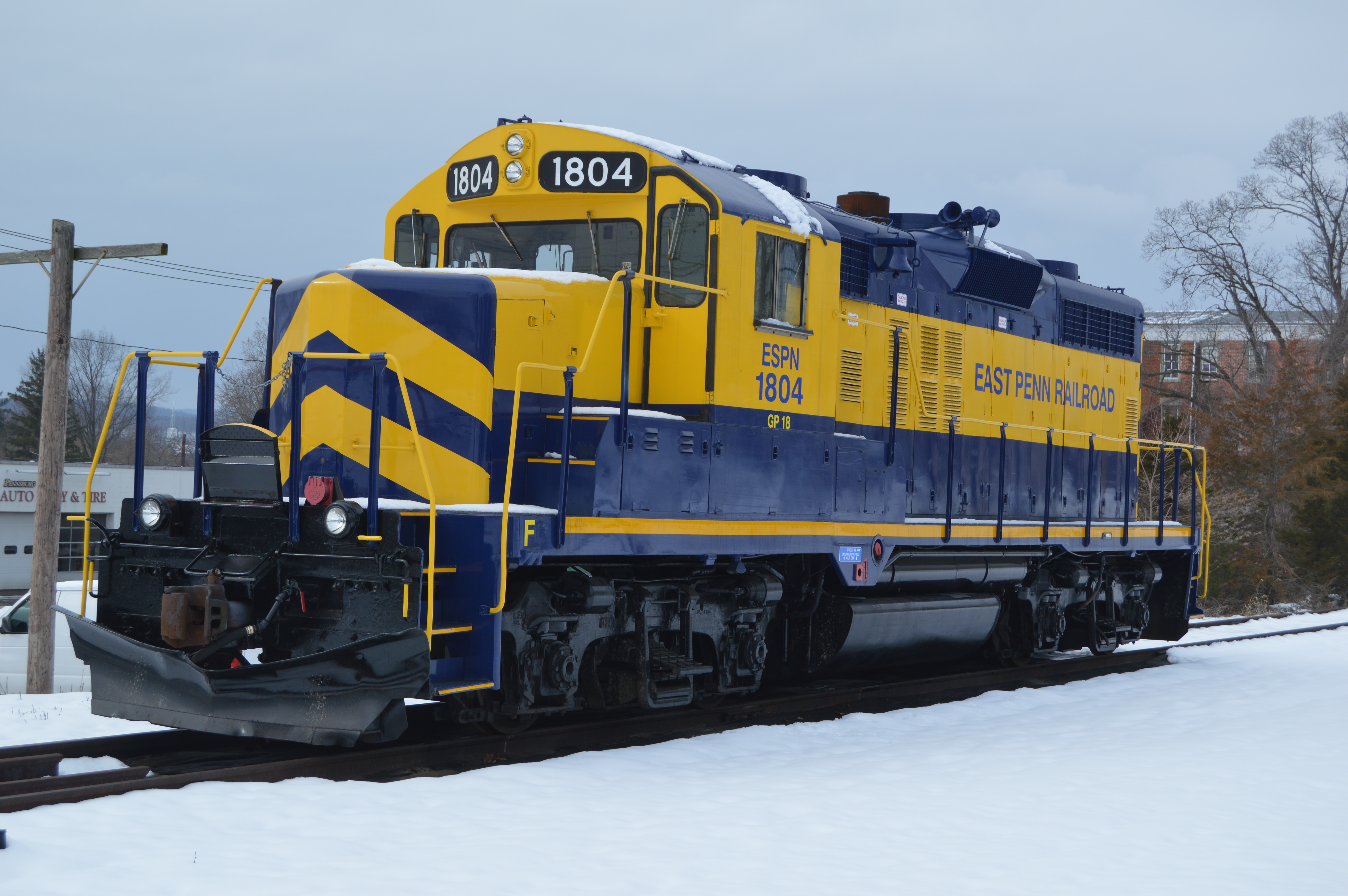

Early, chopped nose
Most of the low-nose first generation EMD’s are the result of modification by the owners. These vary wildly in appearance depending on who rebuilt them and when.

GP30
Unique design, never used again, but serving as a transitional model between the generations before and after.

If you think that looks unusual, check out the high hood version:

Standard, aka “Spartan” Cab
This is the normal basic EMD cab, the face of US railroading for decades. Introduced with the GP35 in 1963 and used up through the SD70.

Final models (SD70s, some SD60s and GP60s) have a housing on the side of the nose for the “ICE” (Integrated Cab Electronics).
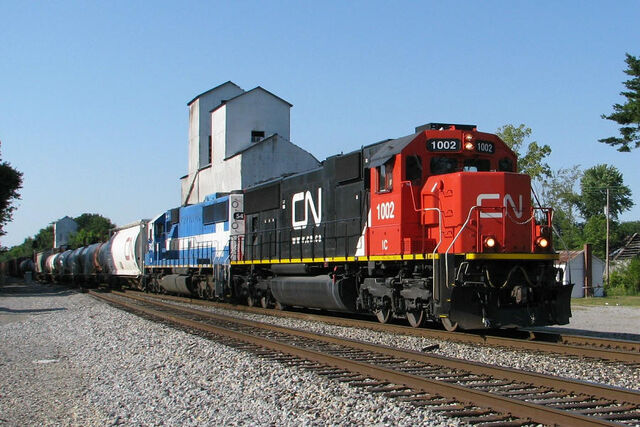
Standard, high nose
Associated with Southern and N&W. Considered more crashworthy than the low version. (It was also cheaper for a long time) These kept their high short hoods well into the NS era.

The Snoot
Elongated nose to hold early radio control equipment. Used only on SD40-2 – taking advantage of the model’s long frame.

“Aerodynamic”
Used only for demonstration units, this is the standard cab with the edges rounded off.
GE
GE’s standard cabs had generally stubbier noses than their EMD counterparts.
There are probably more variations than shown here, but one so rarely encounters older GEs that I’ve never had a reason to try to learn more about it than this.
Early version, low nose
Characteristic of U-boats, Dash-7s. Short, “round but square” nose, rounded roof.

The side view shows how short the nose really is:

Note the first model, the U25B, had a longer nose than its successors.

Early version, high nose
Southern ordered their GE’s with a high nose, because of course they did.
Hunchback cab
Transitional design used on early Dash-8s. The nose is more like the next version, but the round roof is still round. Notice the roof is lower than than body behind it.

Late version
Seen on Dash-8s and the small number of Dash-9s that were not built with wide cabs. The roof is angled instead of round, and matches the height of the overall body. The nose has sharper angles and is not as blunt as the Dash-7 version.
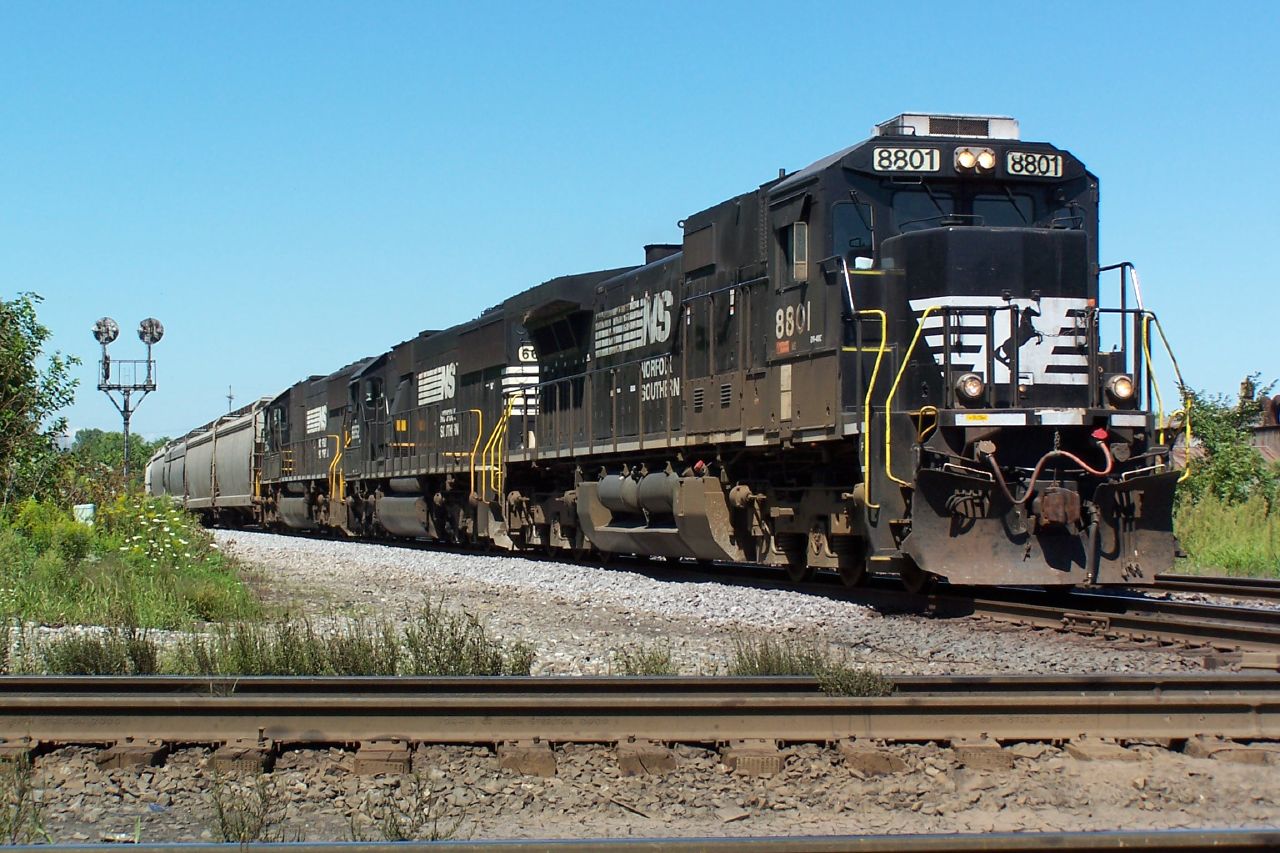

ALCO
All of these are museum pieces now, but relevant in the history of road-switcher design.
1st version
Used on RS-1, RS-2, RS-3, etc., all the way back to 1941. These were by far the most popular ALCO models, so this is the look usually associated with the builder. The short hood is the same height as the long hood, but the cab is notably taller than both.

Later models are “rounder” than the RS-1.

1st version, chopped
No low-nose alternative was offered for these early ALCOs. But like their EMD counterparts, they ended up getting chopped every which way, resulting in a snoot almost like an SD40-2.

2nd version, high
Starting with the RS-11 they made the hood as tall as the cab, and changed the shape of the nose.
2nd version, low
The lowered version of the same nose as above. There appear to have been both one- and two- window variants.

The length of the nose compared to its height is truly crocodilian, especially on the 6-axle RSD-15. The “Alligator” is disproportionately famous for a model that sold only in the double digits.
On the even less successful RS-27, they shortened the nose down to a mere stub of its former self.

Century cab
The Century Series featured a totally new look. They simplified the look of the nose, and angled the front windows. Most models had a very short GE-like nose. The C420 had a different, longer nose than the others.

Santa Fe CF7 Cab
The CF7 program to rebuild F-Units into a road-switcher involved an oddly proportioned parody of the standard EMD cab. Both rounded and angular roofs were used.


NS Admiral Cab
This is used by NS for some of their rebuilds. It is similar to the EMD standard cab, but with sharper edges, higher number boards (which go above the roof), and windows angled outwards (from bottom to top).
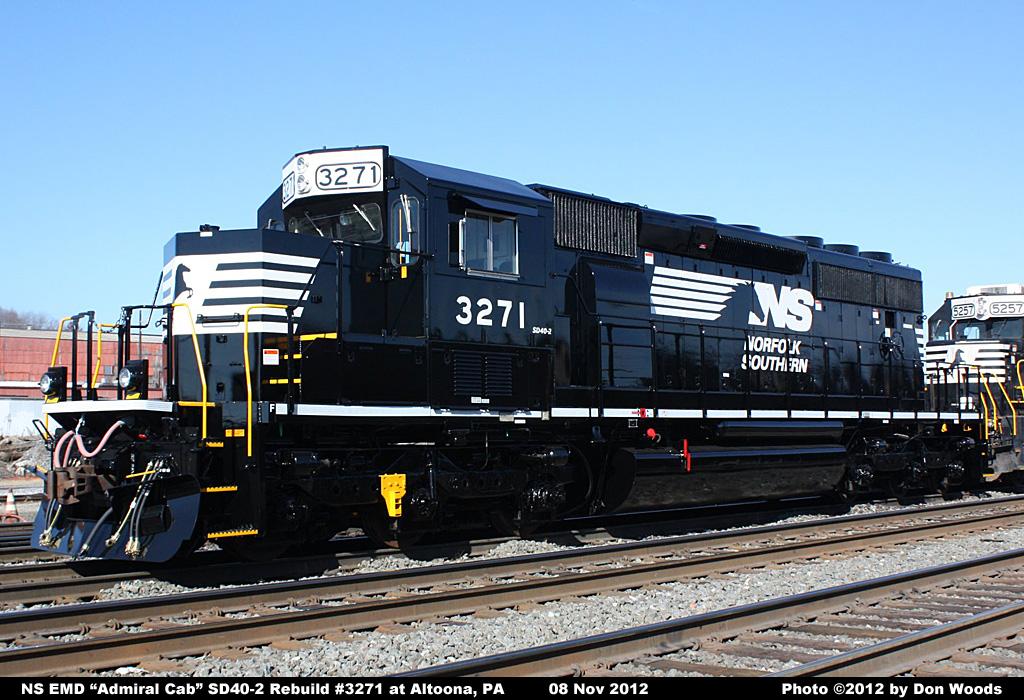
CSX “Dash 3” Cab
Some of CSX’s rebuilds use this blocky design which is very controversial among railfans.
Similarities to the cab used on various NRE Genset models have been noted, but they are not so identical as to suggest that CSX simply bought the cabs from NRE.

Wide-nose Locomotive Variants
There have been several flavors of wide-nose / wide-cab designs over the years. I have not seen a site that has pictures of all on one page. So here they are in rough chronological order.
This article covers only hood unit and cowl units. Carbodies and monocoque designs are a different subject altogether.
Early EMD
The earliest version from 1967 had no crash safety benefits over a standard cab, and was designed purely for aesthetic reasons. Created for the cowl units FP45 and F45, the same design was also used on the DDA40X hood unit.


Passenger-only no-steps version
This was similar to the first design, but lacked stairways and handrails. Used most notably on the ill-fated SDP40F of 1973, and F40C. All locomotives with this cab were cowl units.
The first ones built had a nose almost exactly like the FP45:

On subsequent units the point of the nose, where the door was, was flattened.

When the SDP40F was put into freight service as the SDF40-2, stairs and cutouts in the nose were added.
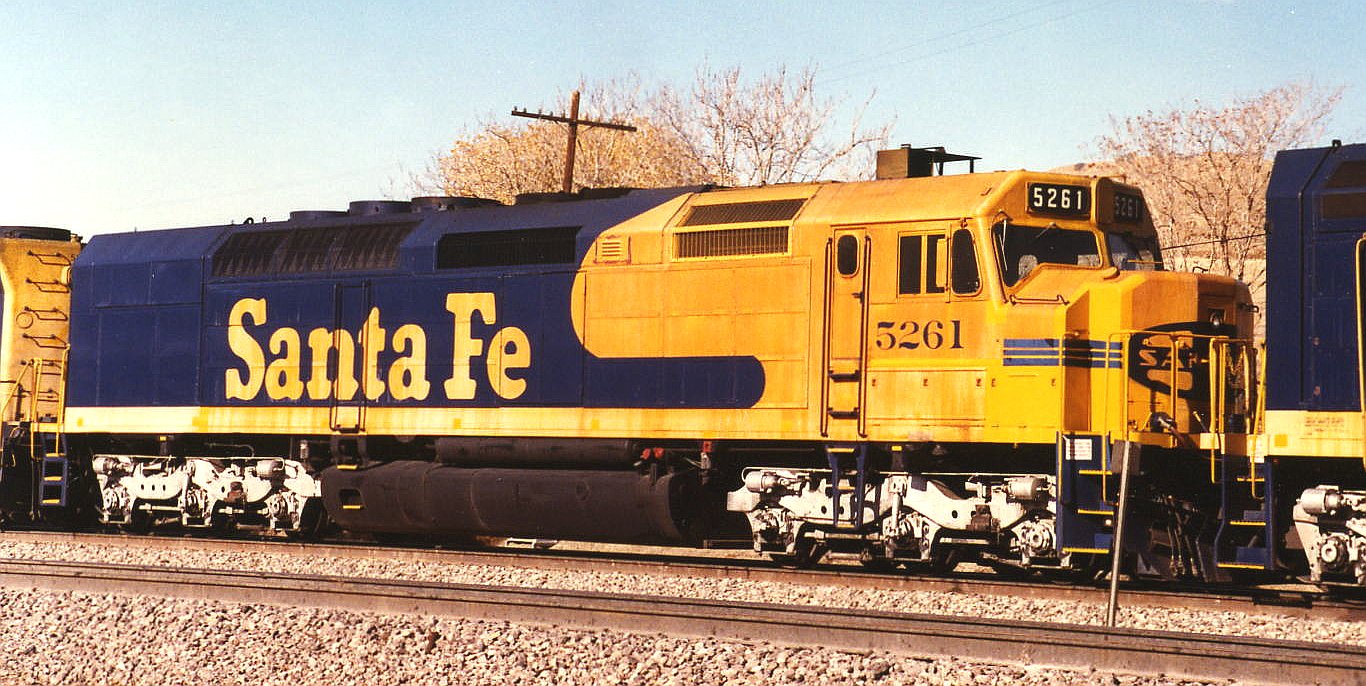
EMD F40PH
Unique and unmistakable for anything else, especially by EMD. The F40PH of 1975 featured a much simpler nose design than its older cousins, and became the face of Amtrak for the next 20 years.
Early GE
GE, like EMD, produced wide-nosed cowl units for passenger service. Unlike the EMD counterparts, these appear to be one-offs, not part of the overall evolution of cab design. Not very many of these were ever built, and none survive.


Canadian Comfort Cab
The true “Canadian” Cab was created by CN in 1973. This was the first cab that was designed with crew safety in mind. All units with this design were originally sold in Canada but a number have been resold to US railroads and can be seen on shortlines and lease fleets.
For many years, US railfans tended to call almost any freight locomotive with a wide nose a “Canadian Cab”, as wide nose designs didn’t catch on down here until the early 90s.
The actual Canadian version can easily be distinguished by the four front window panes. Unlike the earlier (and most later) EMD designs, these windows are vertical rather than slanted back.
CN continued to order these from multiple manufacturers into the 90s, when they switched to the same 2-window models as US railroads.
EMD version
Used on GP38-2W, GP40-2LW, GP40-2W, SD40-2W, possibly others.
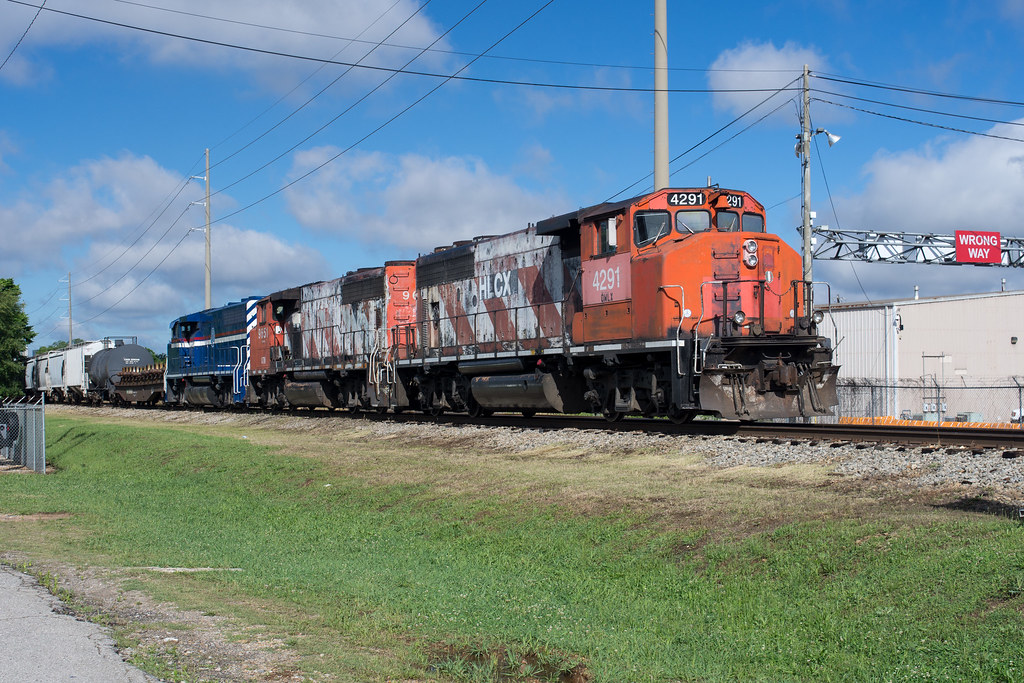
MLW version
Differs from the contemporaneous EMD design by the shape of the windows.

GE version
Looks very similar to the EMD one, but on a GE locomotive. Used on C40-8M, C44-9LW, possibly others.
EMD Triclops
Unmistakable 3-window design. Otherwise very similar to the Canadian cab. Introduced circa 1988 and used for the SD40-2F, F59PH, and the earliest orders of SD60M. This can still be seen on mainline freights, but is rare and much sought after by railfans.
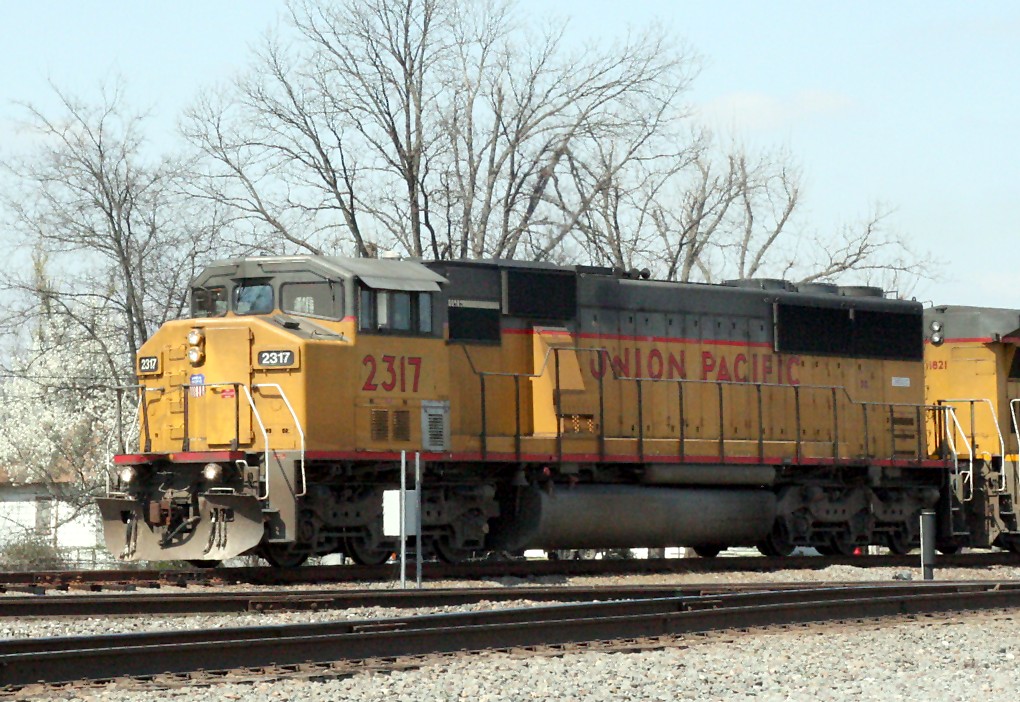
EMD North American Safety Cab
The most numerous EMD variation, starting in 1990. “North American” means the cab was sold in both the US and Canada, unlike earlier versions that were only for one country or the other.
Note superficial resemblance to the original 1967 design, particularly the shape of the windows. One visible, though small, difference is the nose on these is slightly tapered and the corners are more rounded.
Used on SD60M, SD60MAC, SD70M, SD70MAC.

Sante Fe offset-light version
Designed by Sante Fe and used only for the GP60M. This design has a headlight that is not actually in the center of the nose but just to the right of center when facing the locomotive. Unlike the standard EMD wide cab, the nose is not tapered and looks more like the FP45 cab.

Whisper Cab
This looks nearly identical to the standard version, but was the first EMD cab isolated to reduce noise and vibration. A vertical seam is visible on the side of the nose. Used on SD60I, SD70I, SD80MAC, early SD90MAC.
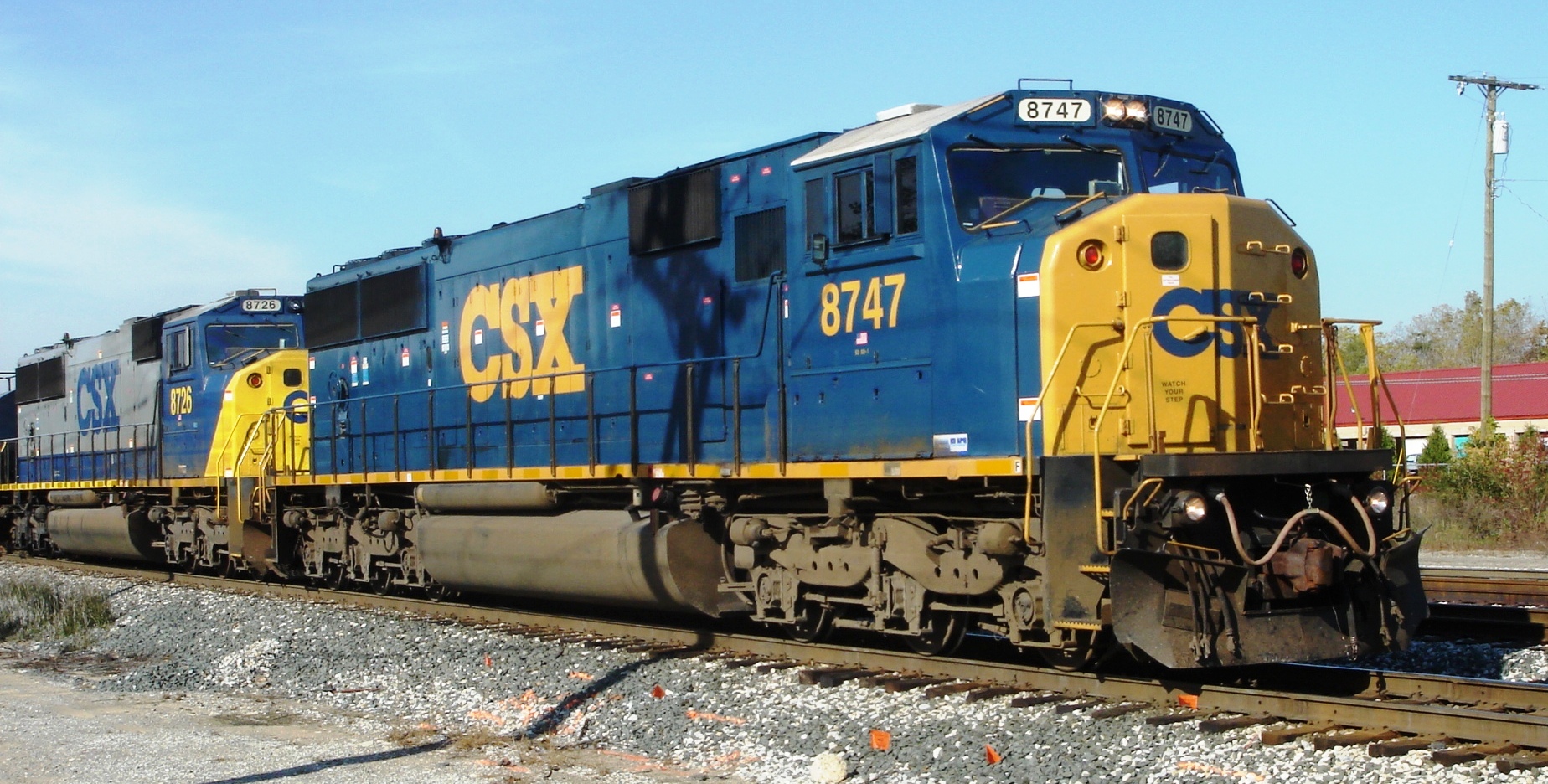
Later “notched” version
Used on late examples of SD70M and SD70MAC. Nose has a slightly taller mid-section to accommodate full-height door, resulting in a somewhat “notched” appearance. The whole nose is less rounded and more angular than before, and no longer tapered.

Current Design, “more notched”
Late SD90MAC-H (1999), SD70ACe (2004-2014), SD70M-2, and several others. The nose is deeply notched to improve visibility. The distinctive teardrop window shape of earlier designs is gone.
On the SD70ACe-T4 produced since 2015, the nose shape is simplified – but still deeply notched – and the original EMD window shape has returned.

General Electric, Current Design
Unlike the constantly changing EMD, GE’s cab/nose design basically looks the same on nearly models since 1990. If it ain’t broke, don’t fix it.
There are thousands on the rails, the most likely thing to see leading any mainline train. Examples include Dash-8, Dash-9, AC4400CW, ES44AC, ES44DC, etc.

Prototype version
This one-off prototype was created in 1988 from a B40-8.

Canadian Dash-9 “Australian” Cab
This seems to have been used in North America only on CN C44-9W’s, and on several GE models sold to the Australian market. Notice the EMD-like front windowpane shape.
Norfolk Southern Crescent Cab
Used for the SD60E rebuild program. This cab is designed by NS and manufactured by Curry Supply.

NS has a similar cab built by RLS that is used on the Dash-8.5 rebuilds.
Dadsplaining Dad-Rock – Part 1
An incomplete history of hard rock, heavy metal, and punk rock music, Part 1 of ???
The subtitle of this blog promises “classic rock”, a promise I have until now failed to make good on.
This post is mainly a series of links to youtube videos illustrating the music genres in question. This is not meant to teach you, the reader, anything you didn’t already know, but may be helpful in explaining these genres to your kids or something. I started making it for that purpose myself, but it has grown way longer than I expected it to.
Band names are links to Wikipedia, song titles are links to music videos.
Keeping the links alive is already turning out to be a constant battle – at least one song was removed from youtube for copyright reasons between when I started writing this post, and when I published it.
Blues, Jazz, early Rock-n-Roll
We begin with a very brief selection of early songs that “look forward” to fuzztone, distortion, and fast guitar pickin’.
- Django Reinhardt – the first guitar hero in the history of recorded music
- Charlie Christian – largely credited with popularizing the electric guitar
- T-Bone Walker – the first prominent bluesman to take up the electric guitar
- Mean Old World (1942) – pioneering electric blues song
- Stormy Monday (1947)
- Jackie Brenston and this Delta Cats (aka Ike Turner band)
- Rocket 88 (1951) – usually cited as the first “Rock and Roll” song, it predates the first wave of “rock” by several years; also one of several early songs where the overdriven guitar sound is said to have been produced by the amp having been damaged prior to recording
- Howlin’ Wolf
- How Many More Years? (1951) – the whole recording is overdriven, including the vocals and drums, but especially Willie Johnson‘s guitar
- James Cotton
- Cotton Crop Blues (1954) – famously overdriven tube amp sound by guitarist Pat Hare
- Chuck Berry – one of the founders of Rock n Roll, influenced basically every later rock guitarist
- Maybellene (1955) – more overdriven than Berry’s later hits, due to use of smaller amp
- Johnny Burnette and the Rock and Roll Trio
- Train Kept a Rollin’ (1956) – this is the version that inspired the Yardbirds; the highlight here is probably the screaming vocals, but the guitar is pretty overdriven for 1956; officially credited to Paul Burlison but some authorities suggest it may have actually been played by Grady Martin (see below)
- Link Wray – important precursor of surf-rock, garage-rock, and instrumental rock in general. He had lost a lung in the Korean War, explaining both the rarity of singing and sound when he did
- Rumble (1958) – infamous sound supposedly created by slicing up the amplifier’s speaker with a razor
- Rawhide (1959) – even fuzzier guitar sound, hard to believe it did not involve a fuzz pedal
- Ain’t That Lovin’ You Babe (1960) – a rare track featuring Link Wray’s vocals, this is probably the purest blues cover recorded by any “rock” (that is, white) artist until the British invasion
- Jack the Ripper (1961)
- Grady Martin – first guitarist known to use a “fuzz” effect, initially caused by plugging the guitar into the wrong channel of the mixing console (or something), then repeated on purpose
- Don’t Worry (Marty Robbins) (1961) – Martin’s fuzz solo kicks in at 1:26
- The Fuzz (1961)
- Dick Dale – king of surf-rock
- Misirlou (1962) – the fast tremolo picking and “exotic” music mode set the standard for instrumental surf rock
- The Ventures – the quintessential early-60s instrumental rock group
- The 2000 Pound Bee (1962) – used a custom-built fuzz box constructed for the band
British Invasion, British Blues, Freakbeat
The standard narrative of the early 60s musical invasion of the US by British bands is that the Brits, being less racist (or at least racist against different races than Americans were), “got” the Blues in a way that most white Americans didn’t. This is almost certainly bullshit.
However, many of these bands did (re)introduce some of the rawer, grittier elements of the music back to American audiences.
- The Rolling Stones
- (I Can’t Get No) Satisfaction (1964) – legendary fuzz tone; not the first use, but certainly popularized
- Paint it Black (1966) – weird minor key and dark lyrics, more than the guitar sound, makes this one ahead of its time
- The Kinks
- You Really Got Me (1964) – power chords! Like Link Wray, the fuzzed guitar tone was allegedly created by poking holes in the amplifier’s speaker. There is a persistent urban legend that Jimmy Page (later of Led Zeppelin) played on this track, which he has always denied.
- All Day and All of the Night (1964) – more of the same
- Them
- Gloria (1964) – major inspiration to garage rock
- I Can Only Give You Everything (1966) – great fuzz
- The Who
- My Generation (1965) – in the 60s these lyrics and attitude were seen as the opening blast of generational war between the baby-boomers and their elders, but in long hindsight it seems more like a harbinger of punk rock 10 years early
- Boris the Spider (1966) – the low, growly vocals here have been cited as influential on death metal. that’s probably bullshit, but it’s still a cool song.
- I Can See For Miles (1967) – noisy, feedback, crashing guitar
- The Yardbirds – predecessor band of Cream and Led Zeppelin. All of these tracks feature Jeff Beck on lead guitar
- I’m a Man (1965) – speed-freak blues with a harmonica vs fuzz-guitar duel in the “raveup” section; widely influential in the garage-rock world; what I really love is the moment when you can actually hear guitarist Jeff Beck switch the fuzz pedal on
- I’m Not Talking (1965) – 12-bar blues dominated by guitar fuzz riffs throughout, one of the first songs to be nothing but fuzz
- Train Kept a Rollin’ (1965) – blues/rockabilly standard updated for the mid-60s fuzz sound; an epoch-making step towards hard rock
- Shapes of Things (1966) – early example of “psychedelic” fuzz-rock
- Stroll On (1966) – re-recorded version of “Train Kept a Rollin'” recorded for the film Blowup; this was one of the only songs recorded by the Yardbirds with both Jimmy Page and Jeff Beck on guitar; already nearly sounds as overdriven as anything Page would ever do with Zeppelin
- Happenings Ten Years Time Ago (1966) – another Beck/Page collaboration; a dissonant psychedelic freakout that sounds almost like prog rock
- John Mayall’s Bluesbreakers
- Hideaway (1966) – where Eric Clapton really established himself; also the reason the Les Paul and Marshall amp became the standard equipment for rock guitarists.
- The Troggs
- Wild Thing (1966) – amazingly primitive recording.. are there even drums or just somebody kicking a crate?!
- Small Faces
- You Need Lovin’ (1966) – Led Zeppelin was obviously inspired by this recording
- The Voice
- Train To Disaster (1966) – fuzztone train to hell!
- The Creation
- Making Time (1966) – noted for using a violin bow on electric guitar, famously later popularized by Led Zeppelin
Garage Rock
Garage rock can be seen as one of America’s first two punches back against the British Invasion (the other, more successful punch, was Motown).
Garage Rock was dismissed as teeny-bopper stuff at the time, merely a derivative of both British bands and of 50s rock and roll.
The retroactive re-appraisal of Garage Rock started with the Nuggets series. In the 70s it came to be seen as the direct ancestor of punk rock, also recognized for having pushed the envelope towards psychedelic or “acid” rock later in the 60s.
This section could use expansion.. or you could just go find more yourself.
- The Kingsmen
- The Trashmen
- Paul Revere and the Raiders
- The Standells
- The Monks
- The Count Five
- The Music Machine
- The Shadows of Knight
- I’m Gonna Make You Mine (1966) – amazing amount of true amplifier distortion for 1966
- The Leaves
- Love
- Davie Allan and The Arrows
- Blue’s Theme (1966)
Psychedelic Rock, Blues Rock, Acid Rock, Proto-Metal (1967-1969)
This was the point when Rock (with a capital “R”) really split off from the pop mainstream. This is a selection of some of “heavier” songs; this period also featured a lot of wispy psychedelia, folk rock, and semi-classical chamber-rock that eventually became Progressive Rock.
This music is obviously directly ancestral to 70s hard rock and heavy metal, but most reckon punk rock’s ancestry to have already split off (see Proto-Punk).
- Cream – the original “power trio” of Eric Clapton, Jack Bruce, and Ginger Baker set the template followed by many rock bands of the late 60s and early 70s
- I Feel Free (1966)
- Spoonful (1966)
- Toad (1966) – one of the first drum solos in rock
- Sunshine of Your Love (1967)
- Tales of Brave Ulysses (1967)
- White Room (1968)
- Crossroads (1968)
- Jimi Hendrix – near-universally acclaimed as the greatest guitarist in the history of Rock, and one of the most distinctive performers in any 20th-century genre; blazed new trails of fuzz-tone, feedback, whammy bar usage; even most of his imitators never really bothered trying to sound like him
- Purple Haze (1967) – unavailable due to copyright enforcement, 1970 live version here
- Foxey Lady (1967) – unavailable; 1968 live version
- Manic Depression (1967) – unavailable; needs link
- I Don’t Live Today (1967) – unavailable; 1967 live version
- Stone Free (1967) – unavailable; 1970 live version
- If 6 was 9 (1967)
- All Along the Watchtower (1968)
- Voodoo Child, Slight Return (1968) – unavailable; 1970 live version
- Jeff Beck Group
- Beck’s Bolero (1966, released 1967) – the band assembled for this one-shot single was the earliest prototype of Led Zeppelin, as it involved Jimmy Page and John Paul Jones; Page and Beck have disputed composer credits for the song ever since.
- Shapes of Things (1968) – compared to the Yardbirds version, sounds like a 70s rock song
- I Ain’t Superstitious (1968)
- Spanish Boots (1969)
- Vanilla Fudge
- You Keep Me Hanging On (1967) – early prog rock
- The Doors – most of their output is too eclectic to be on a hard-rock list
- Break On Through (To the Other Side) (1967)
- Hello, I Love You (1968) – awesome fuzz guitar by Robbie Krieger
- Pink Floyd – much more famous for spacy proto-prog-rock (and in the 70s, full-blown prog), they very occasionally could rock pretty hard
- Jefferson Airplane – “…which cleared the way for Jefferson Starship. The stage was now set for the Alan Parsons Project, which I believe was some sort of hovercraft..”
- The Beatles – the biggest rock band of the 60s, and one of the biggest of all times, only enters into this list late in their career
- Helter Skelter (1968) – unavailable due to copyright stuff; often cited as a “heavy metal” song, it’s arguably not even the hardest rockin thing on the White Album..
- Everybody’s Got Something to Hide Except Me and My Monkey (1968) – the cowbell on this makes it more metal than “Helter Skelter” if you ask me (nobody does)
- Revolution (1968)
- Steppenwolf
- Born to Be Wild (1968) – “Heavy Metal Thunder!” line is one of the earliest uses of the words “heavy metal” in song lyrics
- Blue Cheer – often considered both the most important proto-metal band and a proto-punk band of sorts, due to their extravagantly fuzzed out sound and raw energy
- Iron Butterfly
- In-A-Gadda-Da-Vida (1968) – one of the first songs considered “heavy” at the time; “remember when we used to make out to this hymn?”
- The Pretty Things
- Old Man Going (1968) – this gets pretty damn weird and heavy in the middle section
- The Crazy World of Arthur Brown – not much about the band’s sound is hard rock, but Brown’s theatrics and (later in the song) screaming falsetto are pretty metal.
- Gun
- The Amboy Dukes – the launchpad of Ted Nugent’s career
- Open Mind
- Coven – an openly, and seriously, Satan-worshipping band, with a female singer, in 1969?! That description sounds way more ahead of their time than their sound actually was.. but still.
- Love – yes, the same band that was already listed under Garage Rock, this song is way too proggy to be put in that section
- The Who – the end of the 60s saw the Who moving from “Mod” psychedelia into a long-form hard rock sound
- Pinball Wizard (1969)
- We’re Not Gonna Take It (1969)
- Baba O’Riley (1971)
- Won’t Get Fooled Again (1971)
- Rare Earth
- Get Ready (1969)
The Big Three
These are the three main hard rock bands of the early 1970s, which most other bands are compared to, for better or worse. None of these bands self-applied the label “Heavy Metal” during the period represented here. Like many rock genre names it was generally not a label that bands tended to voluntarily embrace, until much later on. They and their contemporaries were tagged with the “heavy” label by the music critic establishment, largely as an insult at first.
The only one of these bands that is universally considered (retroactively) to have been a true Heavy Metal band the entire time is Black Sabbath.
- Led Zeppelin – firmly rooted in blues, Jimmy Page’s post-Yardbirds supergroup dabbled in a little of everything: folk rock, middle-eastern music, almost-prog, fantastical lyrics, shameless plagiarism, teenage groupies and dead sharks. The topic of whether or not any of their music counts as “metal” is a minefield, pretty much the longest-running argument in rock fandom after “is Paul dead?”, though in the past 10 years or so the “No” side has pretty conclusively won and put the question to rest. This is a list some of their “heavier” songs.
- Communication Breakdown (1969)
- Dazed and Confused (1969)
- Whole Lotta Love (1969)
- Heartbreaker (1969) – one of the archetypal riff-based hard rock songs; the unaccompanied guitar wankfest that occurs at 2:03 inspired many similar breakdowns in hard rock and metal history
- Ramble On (1969) – almost certainly the first rock song about Lord of the Rings
- Immigrant Song (1970) – probably the first rock song about Vikings
- Black Dog (1971)
- Rock and Roll (1971)
- When the Levee Breaks (1971)
- Stairway to Heaven (1971)
- No Quarter (1973)
- The Ocean (1973)
- The Rover (1972, released 1975)
- Custard Pie (1975)
- Kashmir (1975)
- In My Time of Dying (1975)
- The Wanton Song (1975)
- Nobody’s Fault but Mine (1976)
- Achilles’ Last Stand (1976)
- Wearing and Tearing (1978, released 1980)
- Black Sabbath – Combining slow, “lumbering” music and a downtuned, heavily distorted guitar sound with dark lyrics in the style that would retro-actively become known as Doom Metal and Stoner Metal, Sabbath is the gold standard of Heaviness. Most modern fans simply do not recognize anything not built on top of Black Sabbath’s musical legacy as being Heavy Metal at all.
- Black Sabbath (1970)
- N.I.B. (1970)
- The Wizard (1970)
- Evil Woman (1970)
- Paranoid (1970)
- War Pigs (1970)
- Iron Man (1970)
- Electric Funeral (1970)
- Hand of Doom (1970)
- After Forever (1971)
- Children of the Grave (1971)
- Sweet Leaf (1971) – the original “stoner metal” song
- Lord of This World (1971)
- Into the Void (1971)
- Tomorrow’s Dream (1972)
- Supernaut (1972)
- Snowblind (1972)
- Sabbath Bloody Sabbath (1973)
- A National Acrobat (1973)
- Symptom of the Universe (1975) – proto-thrash
- Deep Purple – Purple had been kicking around for several years before theyswitched to full-bore hard rock. They played faster than the other other two here, with more classical influences (especially in John Lord’s keyboards), serving as the prototype of Speed Metal and its ilk.
- Speed King (1970) – note the actual song starts at 1:30, after a freeform noise intro
- Hard Lovin’ Man (1970) – Richie Blackmore’s guitar solo is pretty damn advanced for 1970.. from the overdubbed harmonies at 3:37 to what sounds a like tapping at 4:33
- Black Night (1970)
- Child In Time (1970) – slow-burning build up from quiet beginnings to screaming crescendo, with Ian Gillan summoning a true banshee-wail. The music is based on the instrumental “Bombay Calling” by It’s a Beautiful Day.
- Fireball (1971)
- Highway Star (1972)
- Space Truckin’ (1972)
- Smoke on the Water (1972)
- Burn (1974)
- Stormbringer (1974)
Early Hard Rock / Heavy Metal
At this point, “hard rock” and “heavy metal” were not defined as different genres, and indeed were not really even distinguished from progressive rock yet.
The standard sound was rooted in blues and early rock, usually mid-tempo, with a guitar sound that tended to be powered by fuzz pedals at first and gradually relying more on amplifier overdrive as that technology became more advanced, and a vocal style that bordered on screaming (but would of course be considered “clean” by extreme metal standards).
Songs consist mostly of guitar power chords, swinging/shuffling rhythms inherited from blues, riffs derived from the blues scale, and frequent guitar solos. The bluesy nature is a main thing that distinguishes this style from later styles of metal and rock.
- Grand Funk Railroad – as I wrote many years ago, Grand Funk is possibly the most characteristic rock band of the early 70s. They don’t sound like much before them, and they don’t sound much like anything after them, they are firmly of their era and damn proud of it.
- Humble Pie – though mainly remembered for former Small Faces frontman Steve Marriot, Humble Pie was also the launchpad for guitarist Peter Frampton
- King Crimson – definitely belongs on the prog rock list if I make one, at least one song is pretty heavy
- Jethro Tull – Tull started out as blues-rock and gradually went prog, but along the way they rocked pretty hard
- A New Day Yesterday (1969) – if it weren’t for the flute, you could probably fool most people into believing this was an unreleased Cream song
- Aqualung (1971)
- Cross-Eyed Mary (1971)
- Minstrel in the Gallery (1975)
- Spooky Tooth – believe it or not, the singer of this band is Gary Wright. That Gary Wright.
- Better By You, Better Than Me (1969) – best known via the cover by Judas Priest
- Evil Woman (1969) – unrelated to the Crow/Black Sabbath song of the same title
- Cactus – like Grand Funk, Cactus was one of those bands that was pretty popular at the time but didn’t leave much of a following behind, but they could grind out the blues covers with the best of ’em
- Wishbone Ash – often noted for their two-lead-guitar setup, usually associated with Southern Rock and common much later in the history of Metal
- Mountain
- Mississippi Queen (1970) – in a genre infamous for cowbell, this is the most cowbell song
- Never in My Life (1970)
- Free
- Sir Lord Baltimore – this is one of the bands that you can use to tell if the person who are talking to is into all this stuff – if they’ve heard of Sir Lord Baltimore, you’ve found a friend! SLB is also one of the few examples of a rock band with a singing drummer who actually sang while drumming!
- Warpig – in spite of what you’re probably thinking, this Canadian band was formed too early to have been named after the Black Sabbath song “War Pigs”. Like many of the lesser-known bands here, they produced only one album but it was quite a doozy
- Melody with Balls (1970) – aptly named
- Rockstar (1970) – similarity to Deep Purple’s “Fireball” presumably coincidental
- Uriah Heep – the Heep meandered around in the uncanny valley between hard rock and prog-rock for most of the 70s
- Gypsy (1970)
- Bird of Prey (1971)
- Look at Yourself (1971)
- Easy Livin’ (1972)
- The Magician’s Birthday (1972) – this is included here for sheer ridiculousness of the “oh how they danced, the little children of Stonehenge..” variety – one either hates this sort of thing or loves it I guess
- Lucifer’s Friend
- Ride In The Sky (1970) – similarity to Led Zeppelin’s “Immigrant Song” are supposedly coincidental; yes that’s a french horn doing the “ahahhhhhah!” part
- James Gang – face it, Joe Walsh just rocked a lot more before he got mixed up with them Eagles
- Leaf Hound – another shibboleth like Sir Lord Baltimore – name-dropping Leaf Hound will either demonstrate your early-70s cred, or totally baffle whoever you’re talking to
- Budgie – neither their little bird name nor their stupid album covers hint at the slow, bass-heavy, lumbering riffs to be found here
- Guts (1971) – sounds almost like “Man in the Box” by Alice in Chains, doesn’t it?
- Homicidal Suicidal (1971)
- Drugstore Woman (1972)
- Breadfan (1972) – best known to modern audiences by its Metallica cover
- Crash Course in Brain Surgery (1974)
- Dust – Believe It Or Not! the drummer of this band later became Marky Ramone
- Alice Cooper – also considered Glam Rock, Proto-Punk, the name “Alice Cooper” in this period referred to the entire band
- Focus
- Hawkwind – the most famous band of the “space rock” subgenre, Hawkwind is also notable for launching the career of Lemmy
- Lord of Light (1972)
- It’s So Easy (1974) – 60s fuzz in the middle of the 70s sounds the 90s
- Kings of Speed (1975)
- Motorhead (1975) – point of departure for the band of the same name
- Captain Beyond – cult supergroup with alumni from Deep Purple and Iron Butterfly
- Buffalo – one of Australia’s first hard rock bands, Buffalo was as heavy as anything in their day
- Pentagram – the world just wasn’t ready for Pentagram, and their recorded material from the early 1970s remain unreleased for 20 years
- Montrose – the group that Sammy Hagar came from, for better or for worse
- Edgar Winter Group
Proto-Punk, Glam-Punk
Here we pause the progression of hard rock in the 1970s, and step back to the 60’s to explore the development of punk out of garage-rock roots.
Other than the Velvet Underground, who were too artsy-fartsy to be lumped into a “genre”, these bands were characterized as Hard Rock or Glam Rock by contemporary observers. Later (meaning after the Ramones and Sex Pistols) they were retroactively re-christened as punk forebears.
Even after the deluge of the 1977-style punk rock, there have been continual waves of new punk- or punk-related bands that still sound more like these ancestral bands.
- The Velvet Underground – while they dabbled in all kinds of musical indulgence, drugs, dark lyrics, and beatnick pretentiousness, some of their songs are sufficiently loud to serve as unmistakable milestones.
- The MC5
- (Iggy and the) Stooges – if you’re looking to draw a straight line between mid-1960s garage rock and late 1970s punk, this is the main vein right here
- The Modern Lovers
- Roadrunner (album version, recorded 1972, released 1976) – if anyone ever asks, this is officially My. Favorite. Song.
- The New York Dolls – the Dolls were on the scene immediately before New York punk, and represent its most direct musical antecedent; they sound like a fusion of the Glam tropes with a Stooges intensity
Glam Rock
Glam Rock was closely related to hard rock, but had a glitzy hair-and-makeup image completely different from the “dirty hippie” look of most other contemporary rock. It was an almost exclusively British phenomenon except in the very late phases.
It should be noted the Glam Rock was more of a fashion movement than a musical one. Musically, if glam rock has a central tendency, it would be towards a sound firmly based in 1950’s Rock n Roll – including such trappings as I-VI-IV-V chord progressions, boogie-woogie rhythm guitar, pounding piano, vocal harmonies, saxophone as a main instrument – but updated for 70s production values and hard rock guitar sounds, with a certain pompous grandeur that’s harder to describe in words than it should be.
The same 50’s nostalgia can be heard in much other 70s rock, from Elton John’s “Crocodile Rock” to about half of Bruce Springsteen’s career, not to mention the Rolling Stones and Faces – Glam was musically continuous with its contemporaries and hard to draw a box around. It’s not for nothing that this was also the decade of “American Graffiti” and “Happy Days”.
The musical elements of Glam – especially the pounding beats and “Chuck Berry turned up to 11” guitar – were important influences or inspirations to punk and post-punk, and even more obviously an influence on Glam Metal (especially the 2nd, less metallic wave of bands like Poison).
This list only includes the harder-rocking songs by these artists.
- Mott the Hoople
- Rock and Roll Queen (1969) – “glam rock” wasn’t really a thing yet in 1969, but Mott’s sound was tending that way already with this Stonesy number
- All the Young Dudes (1972)
- One of the Boys (1972)
- All the Way from Memphis (1973)
- T. Rex – the major instigators (along with Bowie) of Glam as the hot trend of the early 70s
- David Bowie – one of the great musical chameleons of the rock era, Bowie’s true “Glam” period only lasted from about 1971 to 1974. But he is probably the name most associated with the style.
- Roxy Music – almost as difficult to pin down as Bowie, and influential across a wide range of genres, Roxy definitely made some contributions to Glam in their early period
- Slade – one of the hardest-rocking Glam bands, a definite precursor of Glam Metal
- The Sweet – managed to transition freely between top 40 bubblegum pop and pure hard rock, actually being pretty damn good at both
- Ballroom Blitz (1973)
- Fox on the Run (1974 version) – lacks the synthesizer and is generally harder than the better known 1975 version heard in “Guardians of the Galaxy”
- Set Me Free (1974) – sometimes cited as an early “glam metal” song, it’s heavy for 1974 by any standard
- Mud – you think a band named “Mud” would sound a lot, well, muddier..
- Lou Reed
- Into / Sweet Jane (1974) – owing more to Mott the Hoople’s cover than to Reed’s own Velvet Underground version of Sweet Jane, the intro (which is basically an independent composition by the band) is famous in its own right
- Rocky Horror Picture Show cast
- The Time Warp (1975 movie version) – the major wave of Glam had washed over by this point, but the movie is a summation of the whole aesthetic
- Meat Loaf
- Paradise By the Dashboard Light (1977) – almost a (self?) parody of the nostalgic tendencies of glam, recorded a time when punk was already kicking down the door, but damn did Meatloaf get the “pompous grandeur” part of it right
Pub Rock
Pub Rock was a “back to basics” style of music based on early Rock and Roll that existed mainly in the mid 70s and almost exclusively in London. Most of the bands involved in Pub Rock were never well-known in the US, and never will be, though a few individuals later became big name as New Wave solo artists.
It is notable mainly for being the genre that Punk Rock directly replaced as the “hot new thing” on the British music scene.
- Brinsley Swarz – one of the earliest Pub Rock bands, and the launching pad for Nick Lowe‘s career
- What’s So Funny (’bout Peace, Love, and Understanding) (1974) – much better known from Elvis Costello’s version of 1978
- Ducks Deluxe
- Dr. Feelgood
- She Does It Right (1974)
- Roxette (1974) – the namesake for the band of the same name
- The 101ers – as wikipedia says, ” notable as being the band that Joe Strummer left to join The Clash”
- Eddie and the Hot Rods
- The Motors
- Dancing the Night Away (1977) – no, I don’t get what this song has to do with a flying snowman, either, but this is the best video I can find
Further Developments in Hard Rock
“Everyone knows Rock attained perfection in 1974”
Meanwhile, after about 1973, Hard Rock itself was developing towards a more “radio-friendly” sound increasingly divorced from the fuzzy sound of the 60s. This development eventually led to Arena Rock.
Gradually, Progressive Rock and Heavy Metal were allowed to go off into their own spaces and be their weird selves in secret, while Hard Rock went mainstream in outlook.
This is still a large chunk of the music played on “classic rock” stations, along with the later Arena Rock.
- Thin Lizzy
- Blue Öyster Cult
- ZZ Top
- Queen – Queen’s earliest material fused prog and glam elements with a solid hard-rock foundation. The overt prog tendencies were gradually muted as they became one of the biggest bands in the world. Freddie Mercury’s huge vocal range and the band’s harmonious, anthemic music was influential to later genres including NWOBHM and Glam Metal.
- Keep Yourself Alive (1973)
- Great King Rat (1973)
- Ogre Battle (1974)
- Seven Seas of Rhye (1974)
- Stone Cold Crazy (1974)
- Now I’m Here (1974)
- Bohemian Rhapsody (1975)
- Death On Two Legs (1975)
- I’m In Love With My Car (1975)
- Tie Your Mother Down (1976)
- We Will Rock You / We Are the Champions (1977)
- We Will Rock You – Fast Version (1977, released 2016)
- Fat Bottomed Girls (1978)
- Brighton Rock (1979) – live version of song originally recorded 1974
- Aerosmith – largely dismissed by contemporary critics as a derivative knockoff of Led Zeppelin and other earlier bands, Aerosmith proved to have staying power and wide influence on 80’s acts like Guns’N’Roses, Mötley Crüe, and others
- Mama Kin (1973)
- Dream On (1973)
- Same Old Song and Dance (1974)
- Train Kept a Rollin’ (1974) – yet another take on this rock-n-roll standard; note that although this was frequently played at Aerosmith concerts, this well-known version is a studio recording with fake crowd noises added
- Walk This Way (1975)
- Sweet Emotion (1975)
- Lynyrd Skynyrd – you won’t find a lot of “Southern Rock” on this list, but a few of the southern bands belong here
- Gimme Three Steps (1973)
- Freebird (1973) – the southern “Stairway to Heaven”
- The Breeze (1974)
- Sweet Home Alabama (1974)
- Saturday Nigh Special (1975)
- Ted Nugent – before Uncle Ted became mainly known for his right-wing politics he was one of the most popular hard rock guitarists of the 70s
- Great White Buffalo (1974) (officially still known as Ted Nugent and the Amboy Dukes at this point)
- Strangehold (1975)
- Dog Eat Dog (1976)
- Cat Scratch Fever (1977)
- KISS – also could be (and sometimes are) filed under Glam Rock because of their heavily made-up look; along with Aerosmith, the main godfathers of 80’s American rock
- Rick Derringer
- Rush – mostly belongs on a separate prog-rock list; first-album, pre-Neil-Peart Rush, was a hard rock band with almost no prog elements; the story is that when the songs from the album first started to be played on the radio, the general public actually thought it was Led Zeppelin
- UFO – like Queen, UFO is often seen as a prototype of NWOBHM and Glam Metal; they are, however, much less well-known
- Scorpions – had to fit them in somewhere.. as a German band, don’t really fit these mostly Anglo-American genre distinctions; they evolved from an almost Prog or even Krautrock style emphasizing long, slowly developed jams (most of which is not covered here) into a tight, metallic outfit for the MTV age
- Nazareth
- Hair of the Dog (1975)
- Love Hurts (1975) – mother of all power ballads?
- Changing Times (1975)
- AC/DC – probably the first Australian band that any American can name, AC/DC’s style of hard rock was so deliberately primitive that people at the time were tempted to lump it in with punk rock rather than the mainstream
- Heart
- The Runaways – could also be classified as punk rock
- Rose Tattoo
- Nice Boys (1978) – famously covered by Guns N Roses
- Molly Hatchet – the other true Southern Rock band in this list
- Van Halen – could also go in Glam Metal, and definitely were a major influence on it, they predate it too much to really be put in there
Arena Rock
Here I am following the definition of “Arena Rock” as laid out by TV Tropes: mainstream radio-oriented hard rock of the late 70s and early 80s. The lines around this category are pretty fuzzy, but you just sort of know it when you hear it. Most of the bands involved in this were not newcomers, but had been around in some form or other for years. This was the style that hard rock and prog-rock musicians seemed to naturally slide into as the 70s became the 80s. This is probably the first style someone unfamiliar with anything else on this page would identify if asked to name some “classic rock” songs.
- Kansas – though retaining more complex arrangements than other bands on this list, it’s hard to argue they shouldn’t be here, what with these vocal harmonies and radio ubiquity
- Boston
- Foreplay / Long Time (1976) – the proggy intro harks back to the early 70s, but once the song kicks in you know what you are in for
- More Than A Feeling (1976)
- Don’t Look Back (1977)
- Foreigner
- Journey
- Styx
- REO Speedwagon
Punk Rock and close relatives
The initial wave of Punk Rock took the Glam/Proto-Punk template a step further away from mainstream hard rock. Songs became shorter, faster, simpler, with fewer (or at least simpler) guitar solos, almost universal lack of any instruments beyond guitar/bass/drums, and deliberately unskilled vocals.
Punk Rock per se was short lived as a major commercial genre. Many of the more successful bands and/or their constituent musicians moved off, by the 80s, into the world of Post Punk, and the ones that didn’t change went back to a small niche market. Punk was largely replaced, in the public eye, by “New Wave“.
However, the stage had been set for descendants of punk rock to flourish underground, in local clubs and small independent record labels, in hand-written fanzines, out of sight and out of mind, to periodically burst back into the rock mainstream over the decades. (Seen this way, these bands here may actually count as the 3rd such eruption, after Garage Rock and Proto-Punk)
- Patti Smith Group – Patti Smith’s activities predated the main wave of Punk, and were significantly different in many respects, but still, she was part of the same scene, and an album out (Horses) out before any of the boys.
- The Dictators – the Dictators are hard to pin down, alternately sounding like hard rock, proto-punk, straight up punk, a precursor to the sleaziest kind of glam metal, or some ungodly combination of all those things
- The Ramones – The first Punk Rock band that most people can name, they practiced a minimalist version of rock, based around rock-steady beats and three (maybe, occasionally, four) power chords, with almost no lead guitar at all.
- The Saints – the first Australian punk band, and one of the first anywhere
- The Dogs – the Detroit-based Dogs held to a more proto-punk sound even as as the Ramones-influenced revolution was taking over
- The Sex Pistols – the first punk band to “make it big”, the Sex Pistols thrived on pure controversy as much (or more) as on the music itself – swearing on live TV, getting banned from the radio in the UK (but selling even more records as a result), bizarre hair and clothing.
- Johnny Thunders and the Heartbreakers – unrelated to Tom Petty’s band of the same name, these Heartbreakers were based around former New York Dolls guitarist Johnny Thunders, and had already been kicking around for 2 years, pioneering punk rock before even the Ramones, before they recorded their first album.
- Richard Hell and Voidoids – Richard Hell was a veteran of the proto-punk scene by the time he put this band together, having been a member of Television and the Heartbreakers (before any of those bands recorded anything)
- Television
- Marquee Moon (1977) – Television was either a throwback to the Velvet Underground style of proto-punk art rock, or the first fully post-punk band, or possibly both at the same time. Either way they didn’t really fit with Punk Rock. Here they are anyway.
- The Clash – their period as a true punk band was very short lived; by 1979 they’d moved out of the punk ghetto, but their brief period was influential out of all proportion on later waves and revivals of punk
- The Damned – like the Clash, the Damned had a long career only the very first part of which was really punk.
- The Jam
- Buzzcocks
- Elton Motello
- Jet Boy, Jet Girl (1977) – compare to Plastic Bertrand – Ça plane pour moi, which uses the same musical backing track for completely different lyrics (most of which are in French, and are a not translation at all)
- Sham 69
- The Misfits – influential “horror punk” Misfits was the launching point of Glenn Danzig
- Generation X
- Dancing with Myself (1979) – an early version of what became a big solo hit for Gen X singer Billy Idol
- Joan Jett
- Bad Reputation (1980) – “freaks and geeks brought me here!”
- Jim Carroll Band
- People Who Died (1980) – they were all friends of mine, and they died. Died!
We’ll stop there for now. Next installment: The 80s, with everything from “Don’t Stop Believing” to “Angel of Death”!
